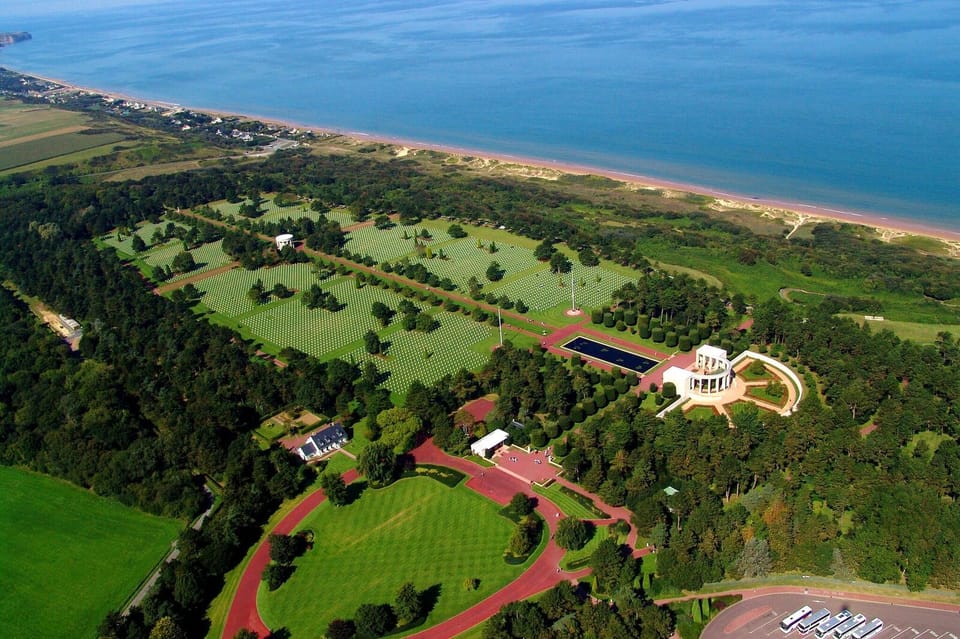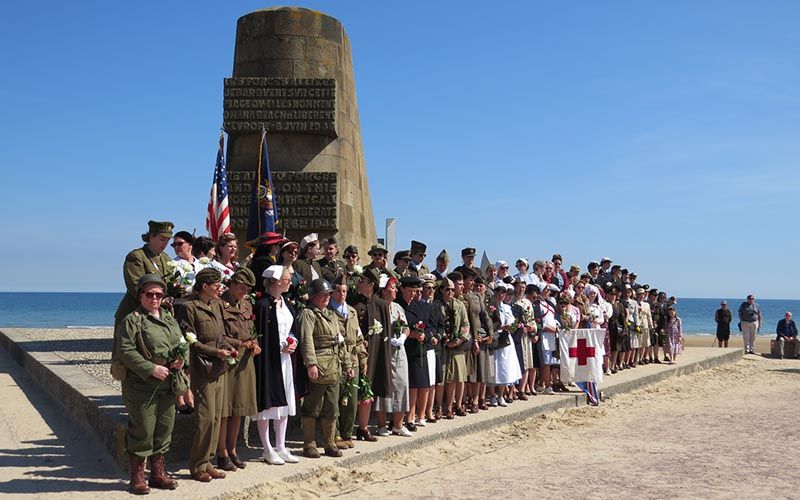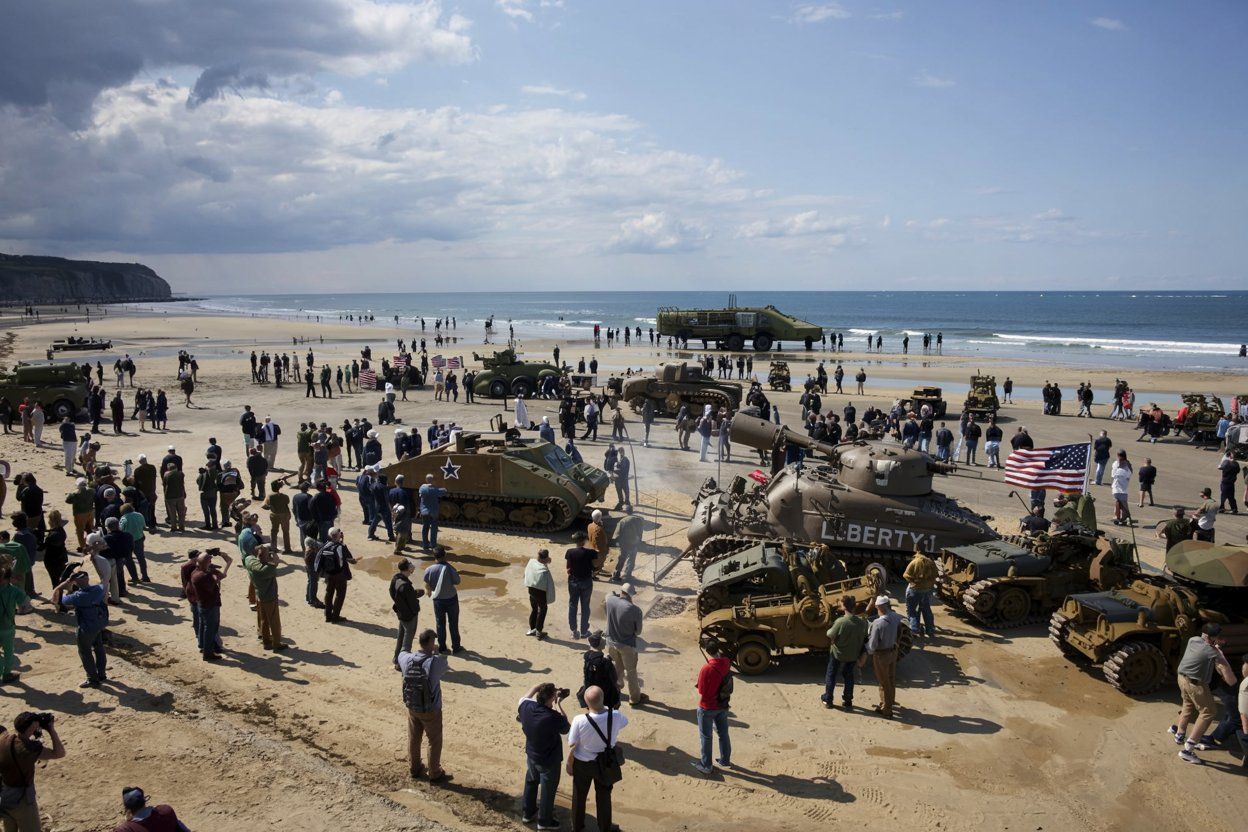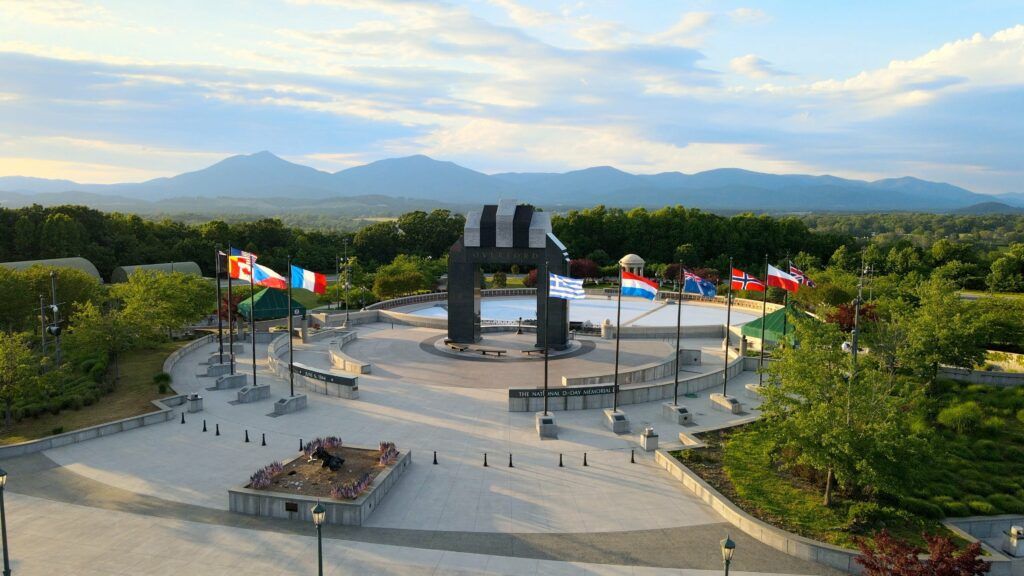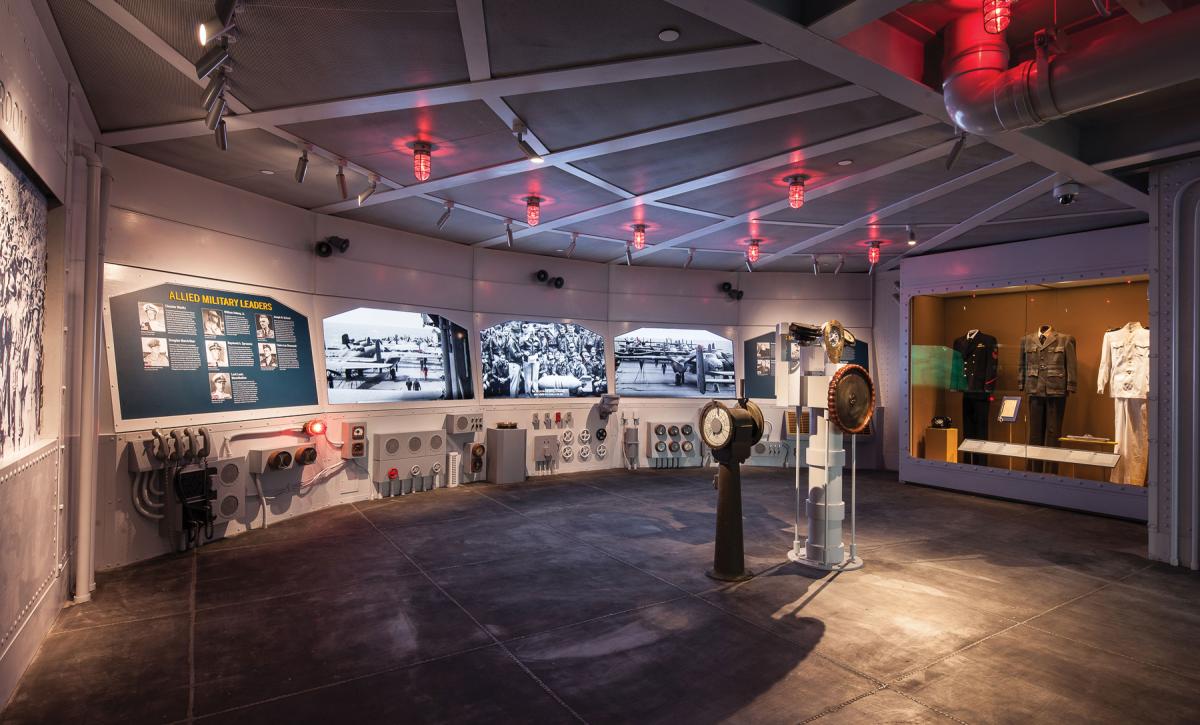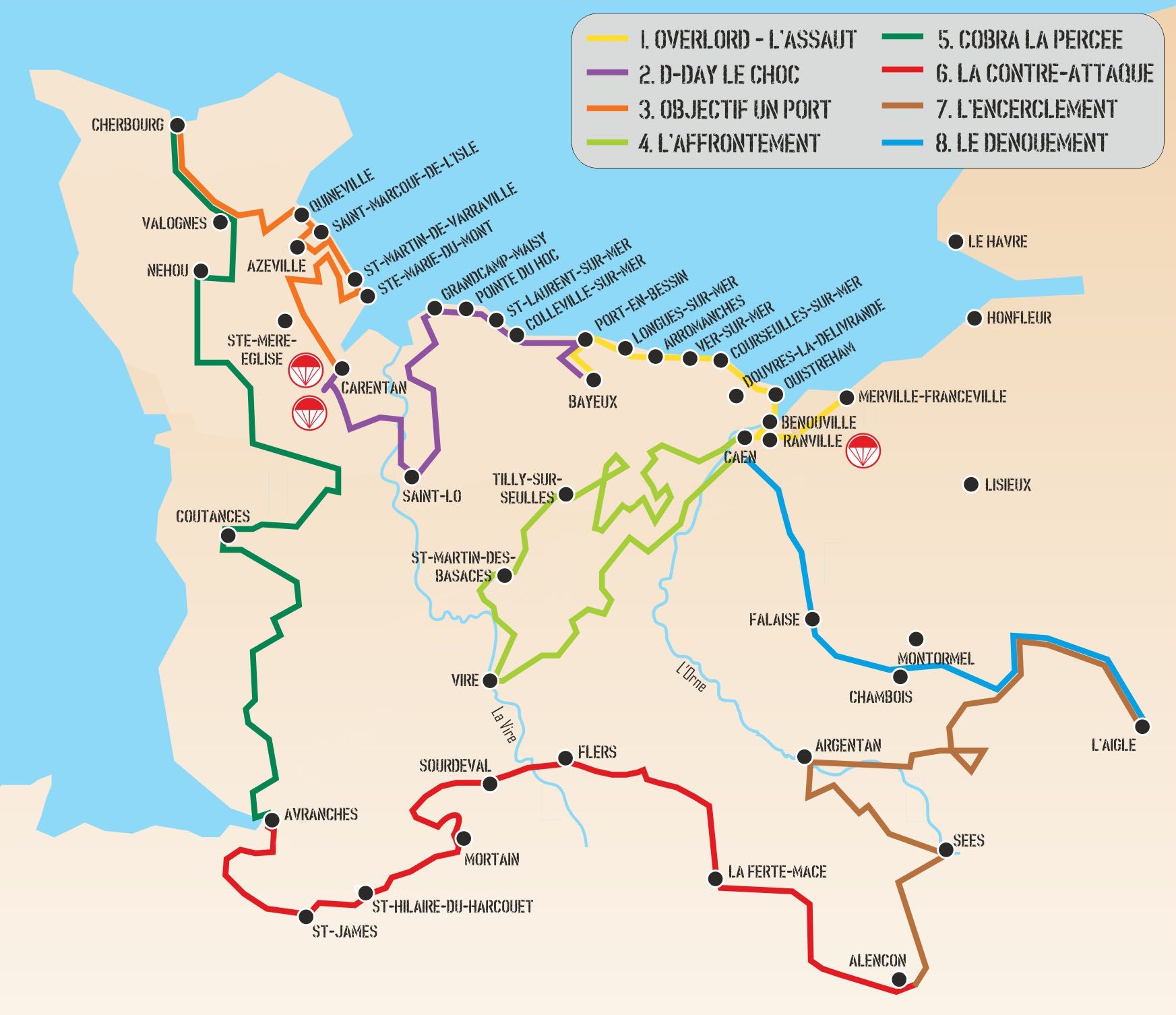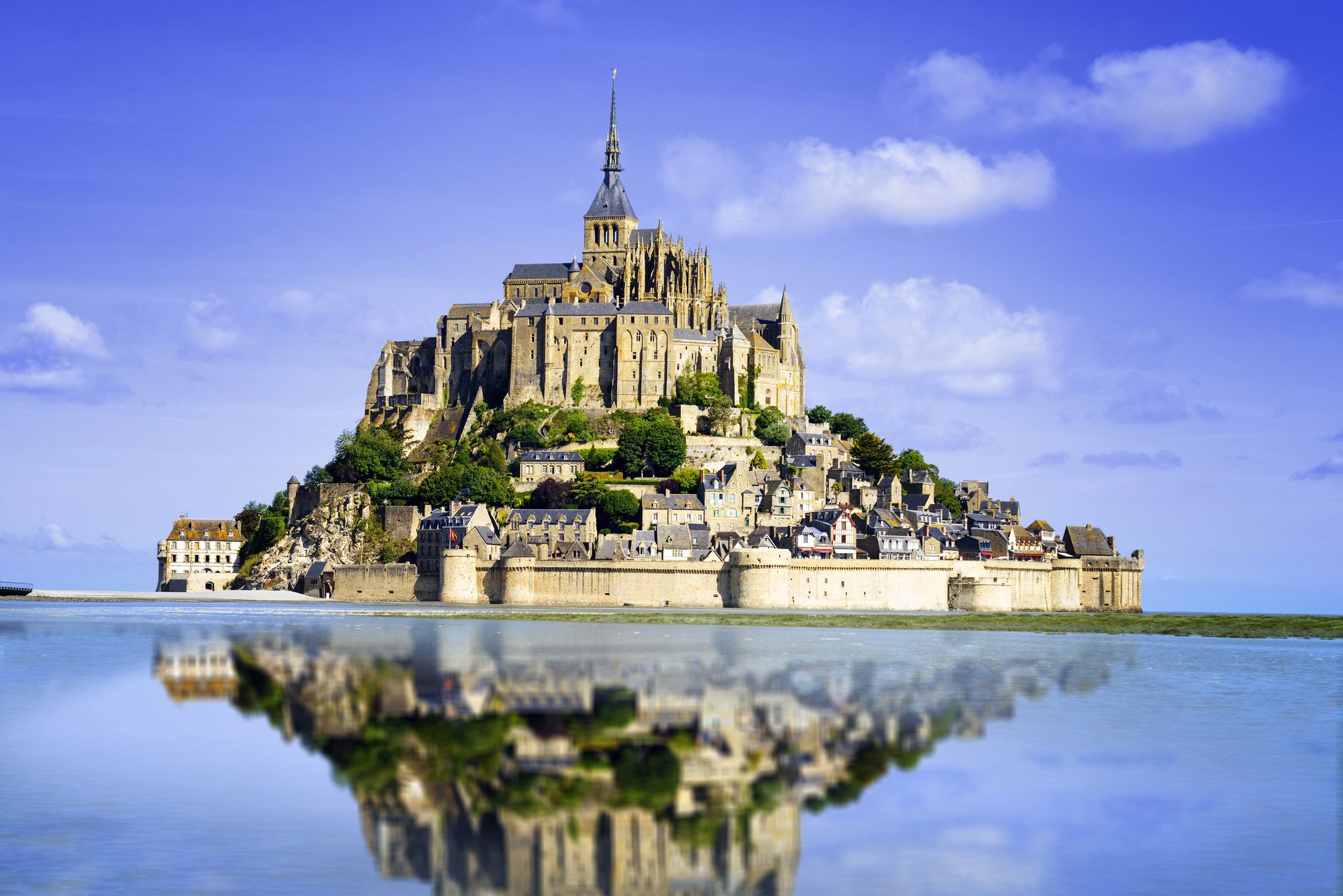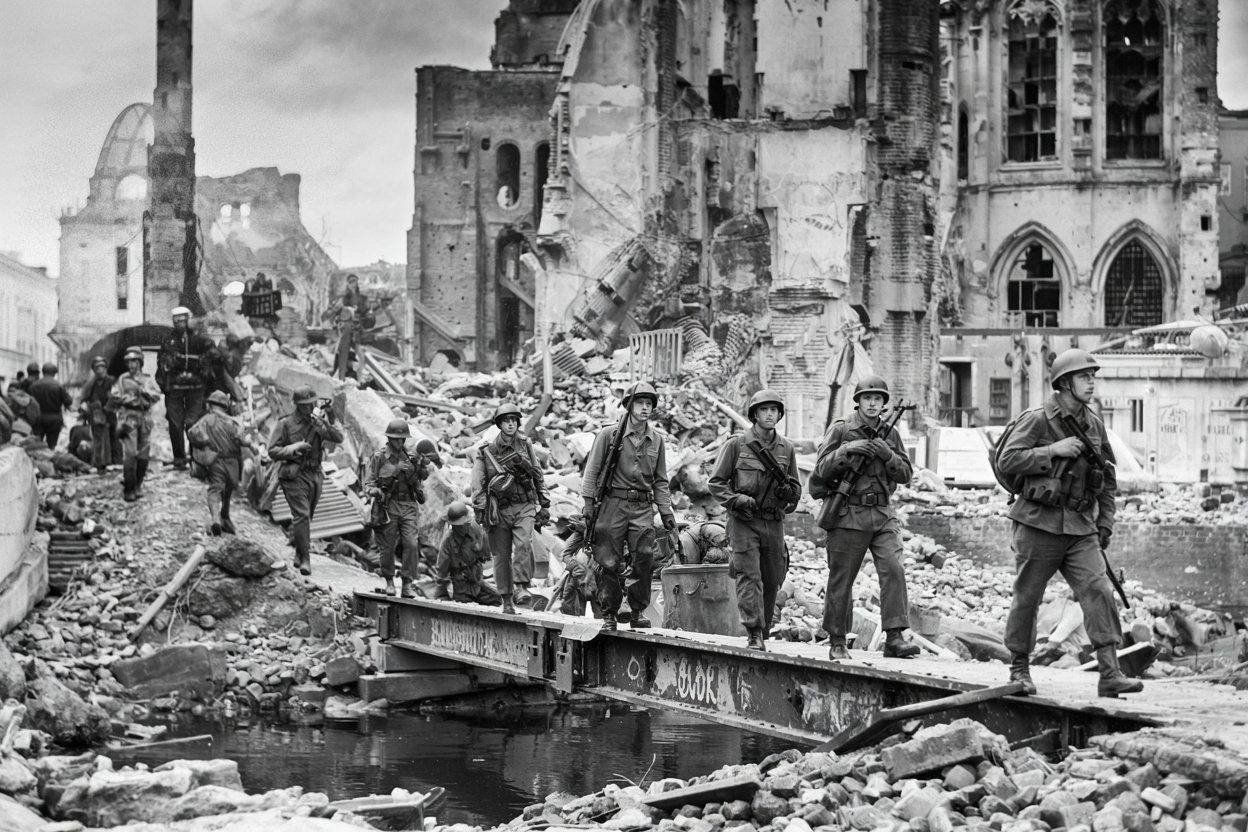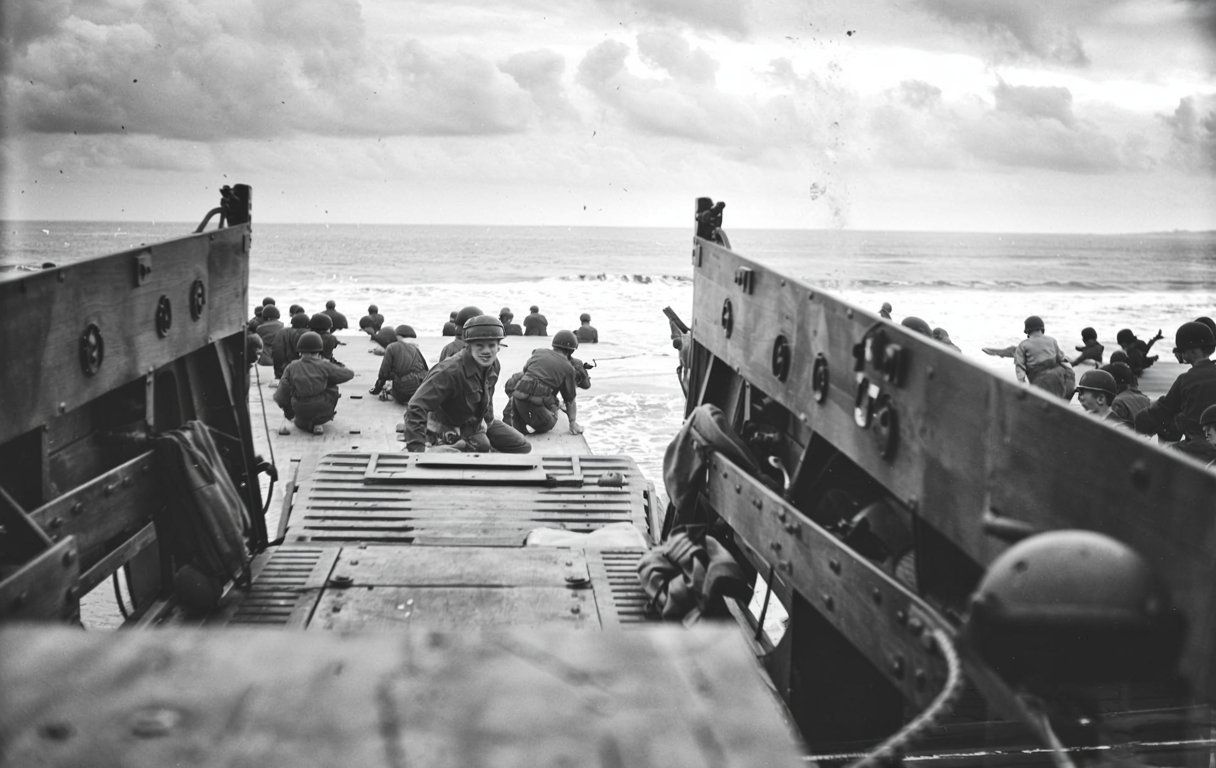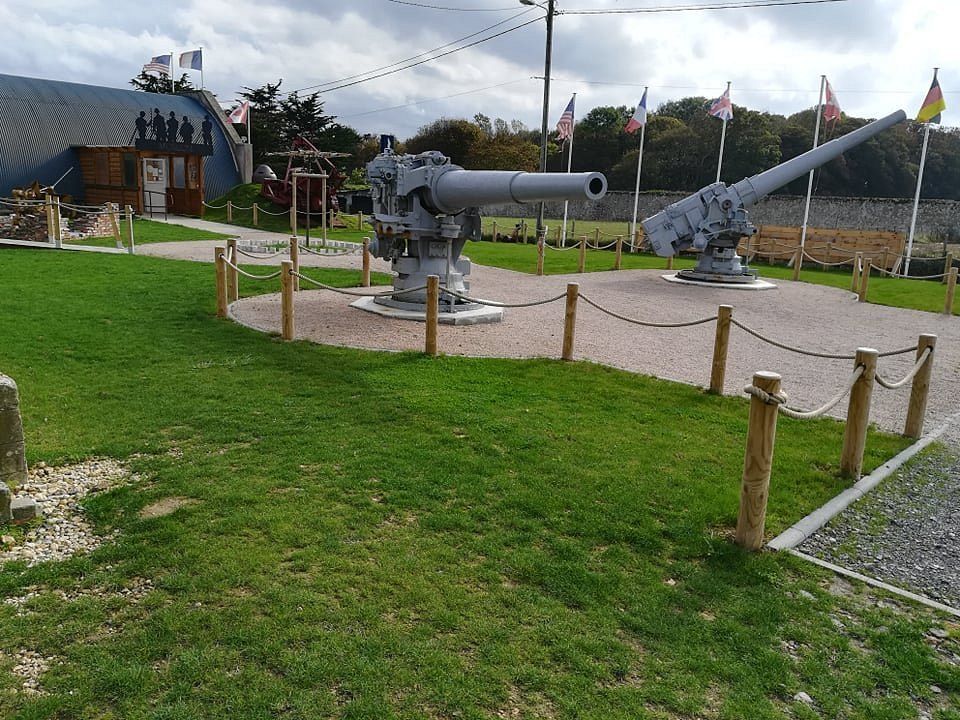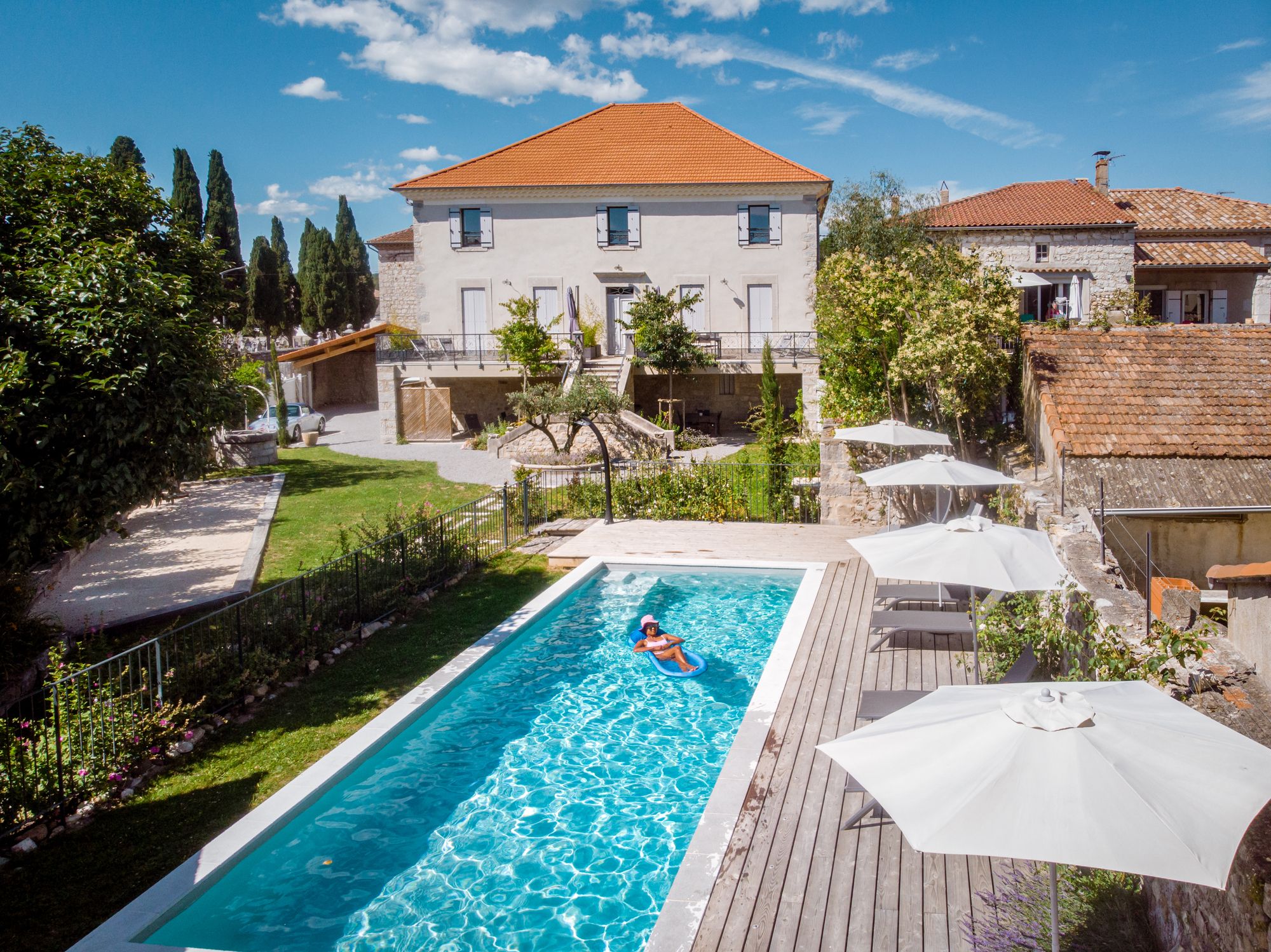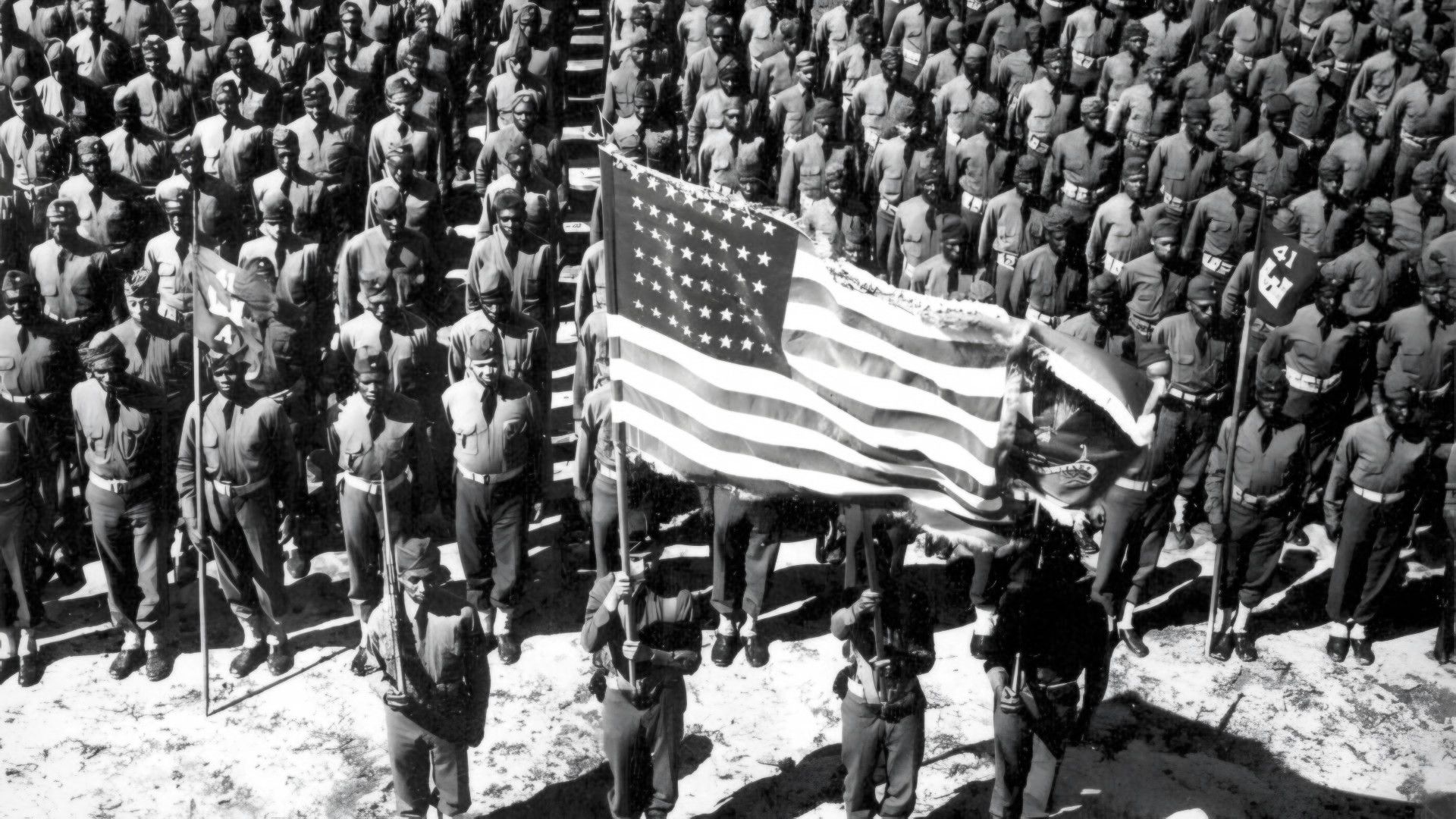In remembering Normandy, we are paying tribute and giving thanks to those men and women who fought so we could live in freedom. Many returned home safely, many did not and of those many are still there. It is the veterans we honor, and the legacy of those lost in this and other campaigns of the Second World.
In the first few hours of the landings at Omaha Beach, the situation was so precarious that General Omar Bradley serious considered abandoning the Omaha landings. However, by the end of the day, across the five landing beaches and the airborne drop zones on the eastern and western flanks, around 156,000 Allied soldiers had arrived in occupied France. They had suffered around 9,000 casualties including 3,000 dead. German losses are not known but are estimated at somewhere between 4,000 and 9,000.
Today, there are some 27 war cemeteries in Normandy – some with fewer than 30 graves, and one with over 20,000. Many more bodies were repatriated, and many never found at all. The cemeteries themselves are maintained to the highest standard. The American cemeteries are looked after by the American War Graves Commissions, whilst the Commonwealth War Graves Commissions looks after the British and Canadian. However, the German Commission is entirely voluntary and relies on gifts and collections to further its work. During the summer months one may see international school children tending the graves. Graves can also be found in more than 75 church or communal cemeteries around Normandy.
We hope the information provided here will give you a sense of the scale of the sacrifice that came with the liberation of this little corner of Europe, and provide some useful information should you wish to make your own journey to these incredibly serene locations.
American Cemeteries
Some Americans on D-Day were experienced veterans of North Africa and Sicily landings, but many were green recruits with no combat experience. Training was intense, and not without its own dangers. In April 1944, around 750 Americans GIs were killed during Exercise Tiger involving mock landings at Slapton Sands on the British south coast. Several German E-Boats penetrated the flotilla, sinking two LSTs and damaged two more.
Colleville-sur-Mer
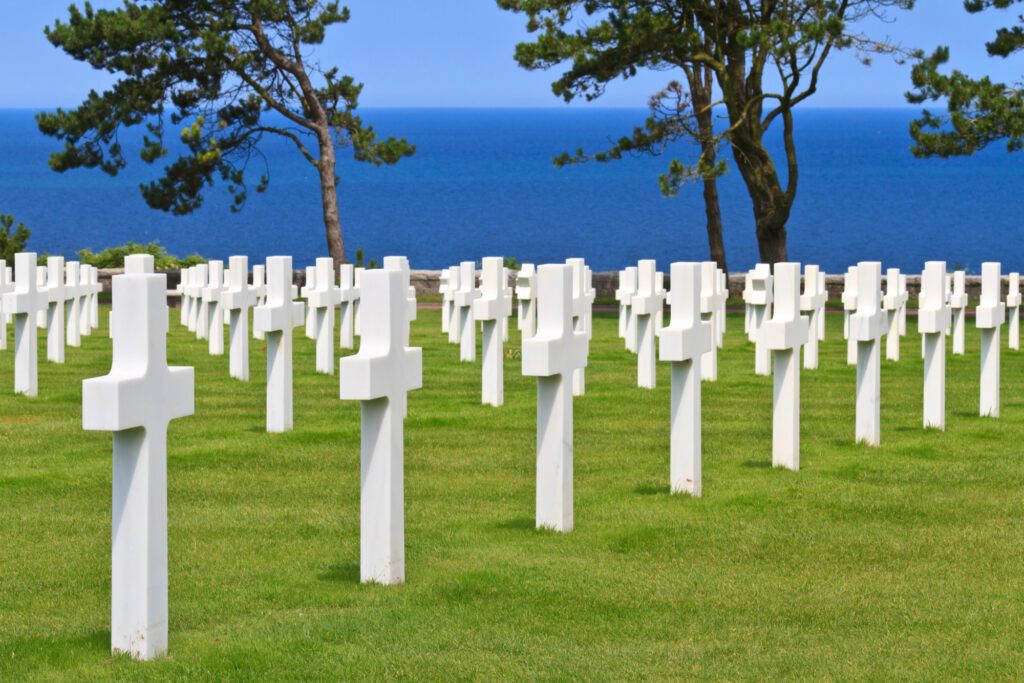
The Normandy American Cemetery at Colleville-sur-Mer stands as a solemn tribute to 9,388 American servicemembers who made the ultimate sacrifice during the Normandy Campaign. Overlooking Omaha Beach where many fell, its pristine rows of white marble crosses and Stars of David stretch across 172 meticulously maintained acres.
This hallowed ground not only honors the fallen through its memorials and Wall of the Missing, but serves as an enduring reminder of the price of freedom and the unbreakable bonds between the United States and France forged in the crucible of liberation.
Brittany American Cemetery at Saint-James
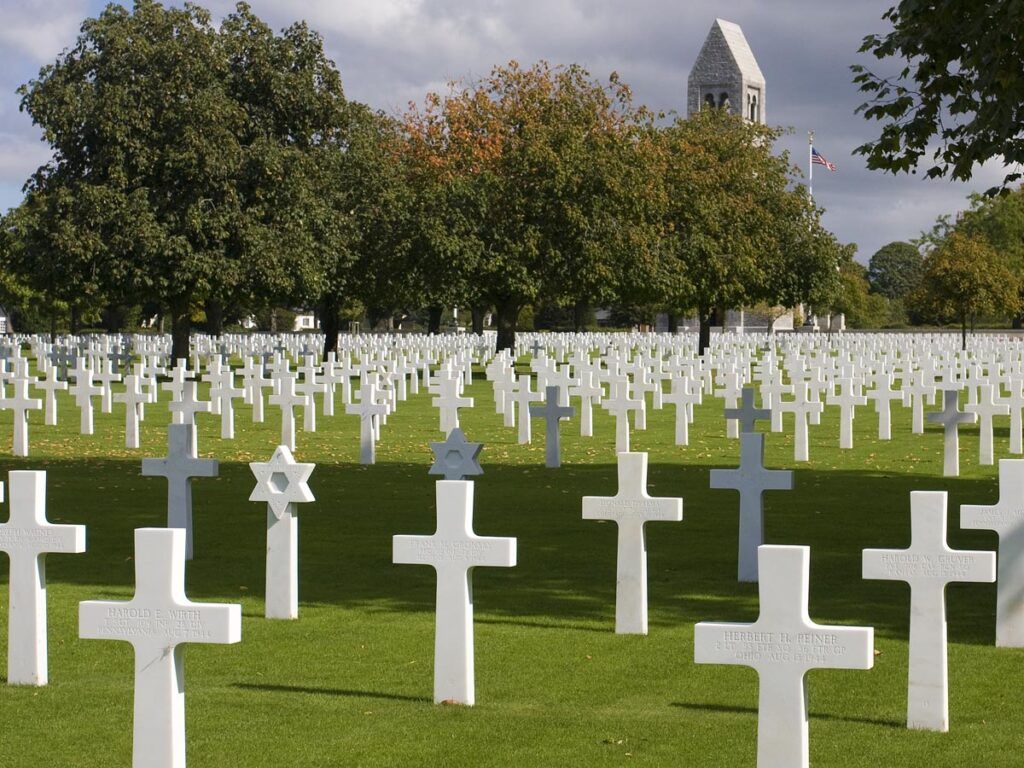
The Brittany American Cemetery in Saint-James, France is a solemn memorial located near the northeastern edge of Brittany, spanning 28 acres of meticulously maintained grounds. Established on August 4, 1944 by the U.S. Third Army as a temporary cemetery after the region was liberated by the 8th Infantry Division, it now serves as the final resting place for more than 4,400 American war dead from World War II, with nearly 500 additional names inscribed on the Walls of the Missing.
The cemetery not only honors those who made the ultimate sacrifice but also symbolically connects to the historic pilgrimage paths leading to Mont-Saint-Michel and Santiago de Compostello through its Saint James association and scallop shell motifs, creating a powerful place of remembrance and reflection.
British Cemeteries
With the exception of raids and special operations, no British troops set foot on French soil between the Dunkirk evacuation and D-Day. On 6th June over 60,000 British soldiers landed in Normandy numbering almost as many as the American forces. We have listed here the sixteen main Commonwealth War Commission Cemeteries, both there are many other graves located in small civilian churchyards across Normandy.
Banneville-La-Campagne War Cemetery
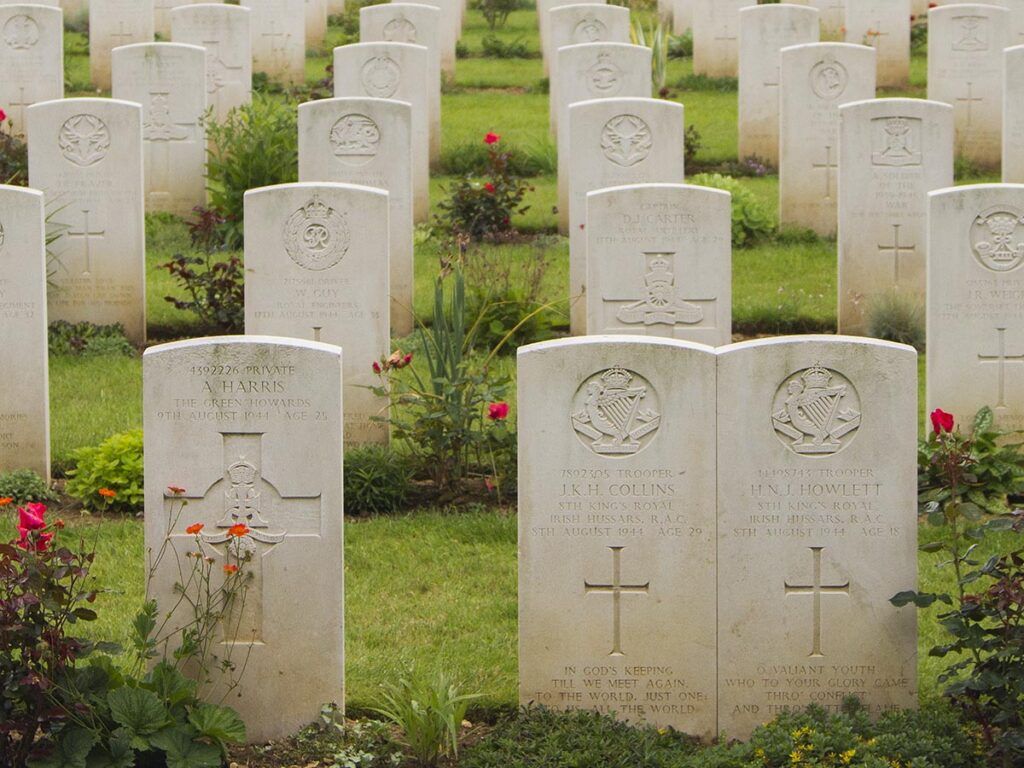
Ten kilometers east of Caen on the D675 between Troarn and Caen lies the village of Benneville-la-Campagne. The entrance to the cemetery is almost opposite the Renault garage and just beside an old ruined building. There are small lay-bys on both sides of the road for parking.
The cemetery is quite large and forms an elongated L-shape. The graves themselves are a short walk from the entrance through newly planted saplings which, once matured, will form a beautifully shaded path.
Amongst the 2,170 graves here are 140 unidentified remains and five Polish dead. Predominantly, those buried here fell during the battles around Caen, Operation Goodwood and battles of the Falaise Gap. Casualties range from 17 to 45 years of age. Among those buried in this cemetery are 6 who also had brothers who were killed elsewhere during the Second World War.
Bayeux War Cemetery
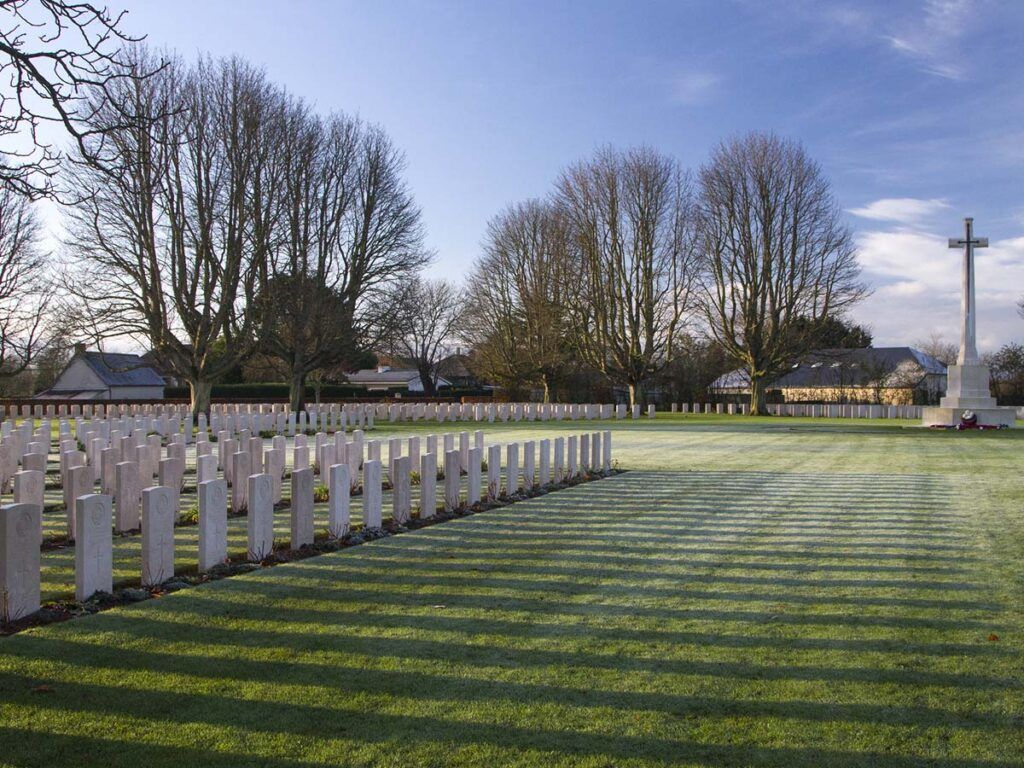
Located on Bayeux’s D5 ring road, the Bayeux War Cemetery is situated opposite the Bayeux Memorial, with informal parking available on a grass verge near the Normandy Battle Memorial Museum. As the largest Commonwealth cemetery from World War II in France, it contains 4,144 Commonwealth burials (338 unidentified) and over 500 other war graves, predominantly German. Completed in 1952, the cemetery holds the remains of those who died in the surrounding areas and in nearby hospitals, including Victoria Cross recipient Corporal Sidney Bates.
The Bayeux Memorial stands opposite the cemetery and commemorates more than 1,800 Commonwealth land forces who perished in the early stages of the Normandy campaign with no known graves. Though Bayeux itself experienced less fighting than other Norman towns, it holds historical significance as the first major French town to be liberated, making this site an important memorial to those who fell during the D-Day landings, the subsequent Normandy campaign, and the advance to the River Seine in August 1944.
Brouay War Cemetery
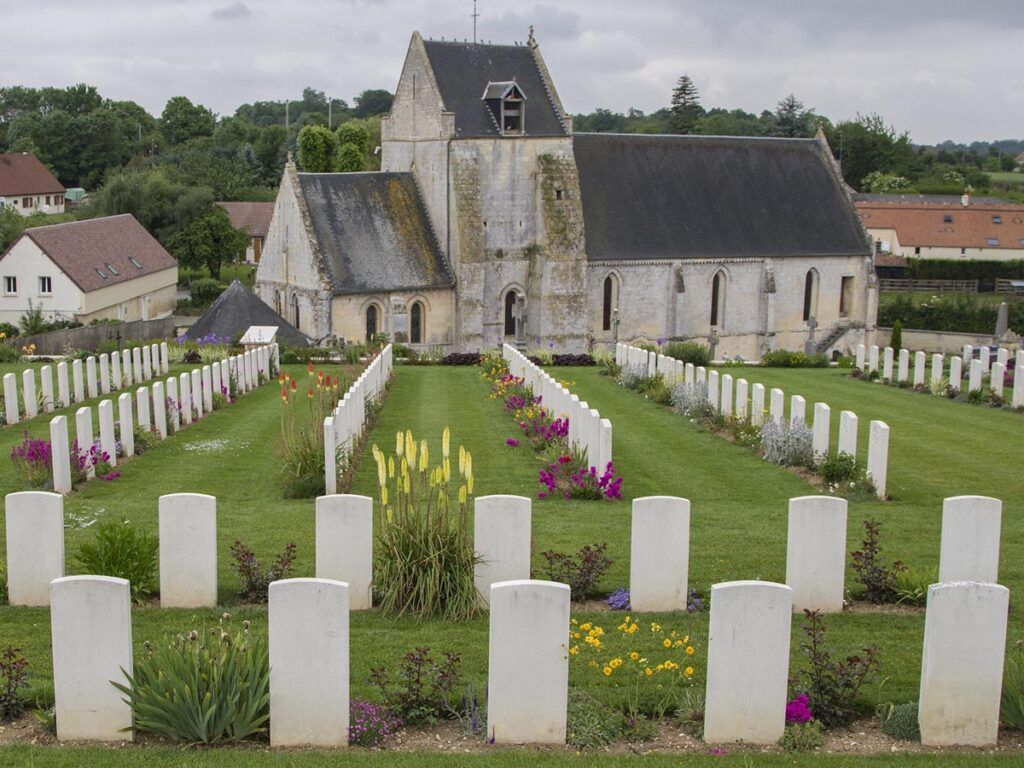
Brouay Cemetery is unique amongst the Normandy war cemeteries in that you must first pass through a civilian village cemetery to gain access. The village of Brouay is situated about half way between Caen and Bayeux off the D217. It’s proximity to the church makes finding the general location fairly easy. Because of the steps required to reach the Cemetery wheelchair access is not possible. There is no dedicated car parking here.
Brouay War Cemetery is quite different from the other Commonwealth War Graves Commission cemeteries. Although still designed by Philip D. Hepworth, and comprising many familiar components, it has a unique atmosphere. The close proximity to a village cemetery makes apparent the stark contrast between civilian and military cemeteries, and highlights just how much care and attention goes into both the design and maintenance of a war cemetery. The remains of 377 fallen soldiers are buried here, having been killed during the capture of Caen and the battle to close the Falaise gap.
Cambes-en-Plaine War Cemetery
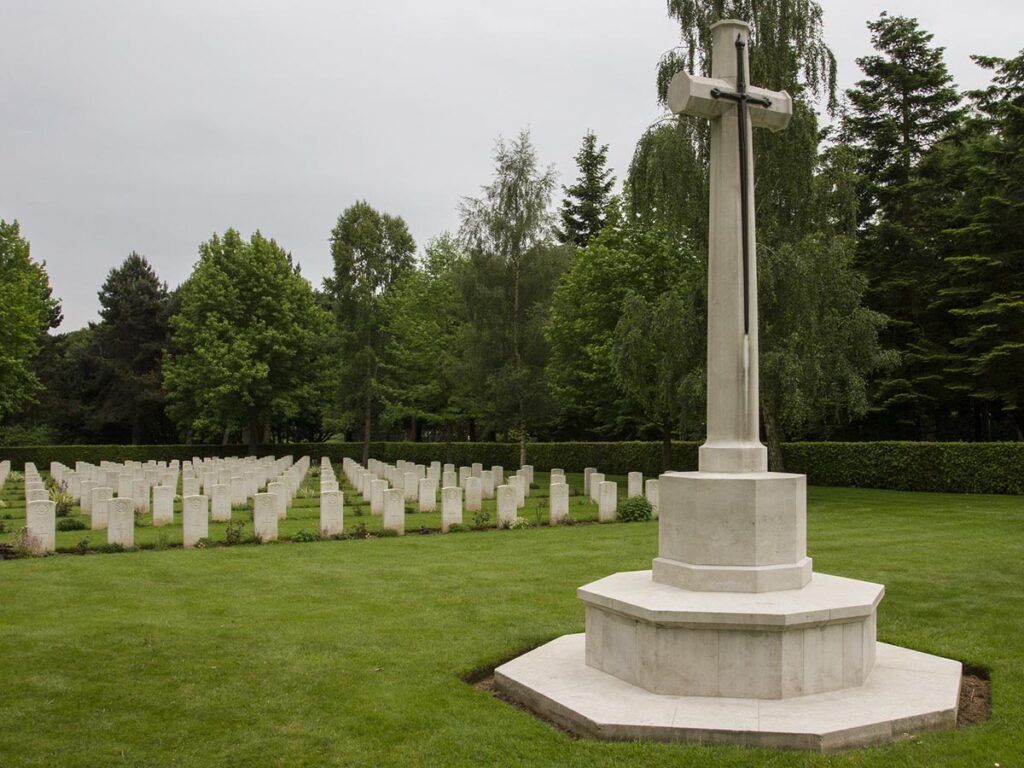
Seven kilometers north-west of Caen is the cemetery at Cambes-en-Plaine. Situated on Rue du Mesnil Ricard, just off the D220A. There is ample off road parking just a short distance away and apart from a single step the entrance is accessible to all. The cemetery is quite small with only British burials. It is bordered on three sides by beautiful mature trees and tucked behind a small hedge facing the headstones is a bench to allow quiet contemplation in the tranquil surroundings.
There are 224 burials, with most of the graves belonging to the 59th (Staffordshire) Division, and in particular the South Staffordshire and North Staffordshire Regiments. Both of these units were involved in Operation Charnwood – the final attack on Caen. It was during this battle, between 8th and 12th July that most of those interred at Cambes-en-Plaine were killed. Just a short walk along the road from the cemetery entrance is a memorial to the 2nd Battalion The Royal Ulster Rifles. It was soldiers from Ulster Rifles who captured the village of Cambes-en-Plaine on 9th June.
La Délivrande War Cemetery
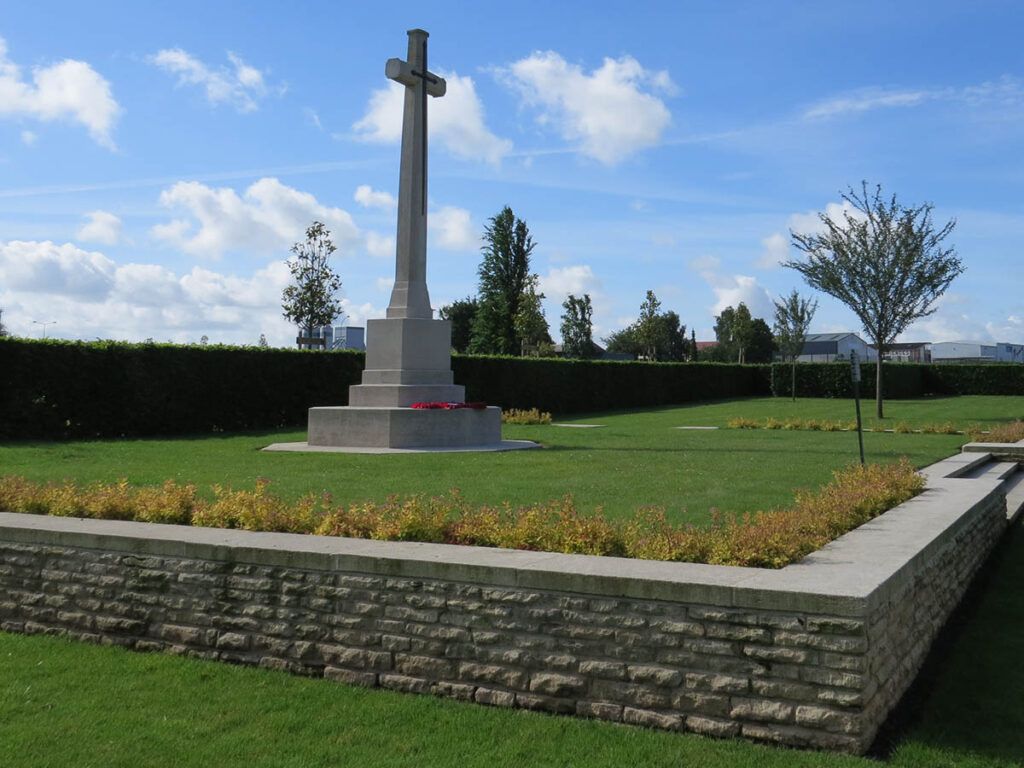
Douvres-la-Délivrande is a village 14 kilometers north of Caen. Following the D7 northwards from Caen to Langrune-sur-Mer, the War Cemetery can be found after about 12km on the right side of the road. We found the only parking available to be for the adjacent civilian cemetery along Rue de la Fossette. There was plenty available, and at the time the rear service entrance to the War Cemetery was open allowing us to slip in the back. At the front entrance, there are no actual gates – rather chains affixed between pillars. In order to gain access, one end of the chain can be unclipped from its hook.
The Cemetery follows the familiar Hepworth design and despite being situated along a main road still carries a quiet and peaceful atmosphere. There are a number of double headstones within the Cemetery, including some marked “Buried near this spot”. Those interred at Douvres-la-Délivrande were mainly killed on 6th June and the landings on Sword beach, particularly Oboe and Peter sectors. Others were brought in later from the battlefields between the coast and Caen. A total of 942 Commonwealth dead are buried here, with 63 of the graves containing unidentified remains. The cemetery also contains the graves of 180 German war dead.
Fontenay-le-Pesnel War Cemetery
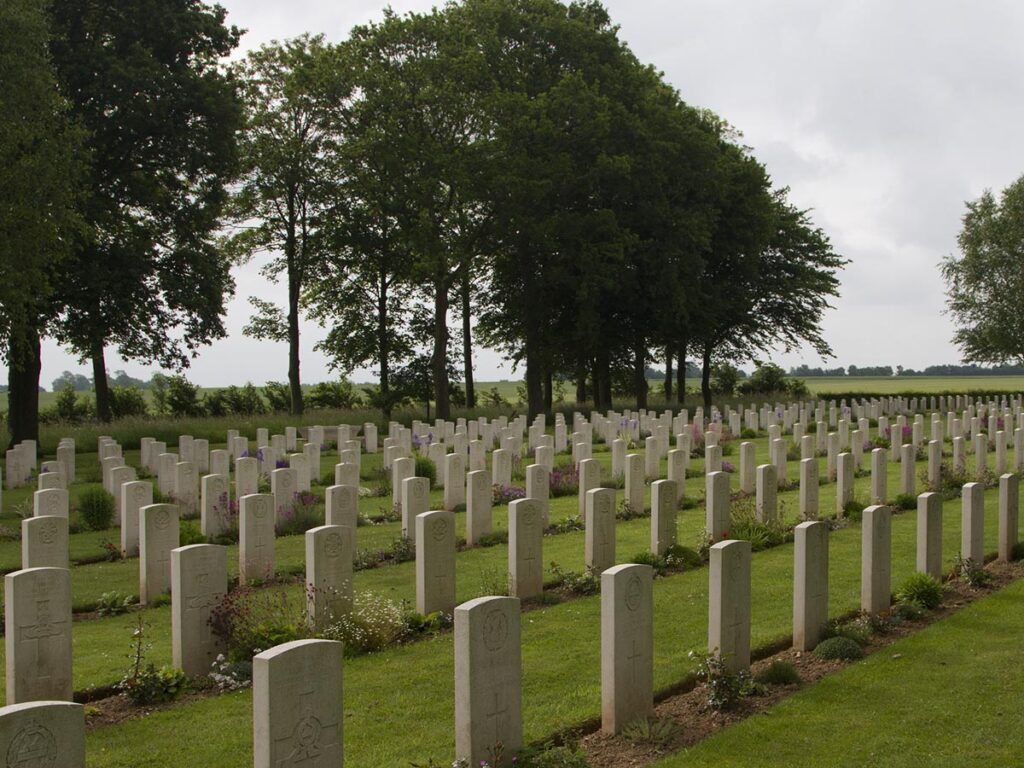
The village of Fontenay-le-Pesnel lies 16 kilometers west of Caen on the D9 towards Caumont l’Evente. The Cemetery is just off the D139 one kilometer south-east of the hamlet of St Martin. Easily seen before the Cemetery itself is a large memorial to the 49th (West Riding) Division which sits opposite the entrance to the unpaved road that leads to the Cemetery. There is a small area for parking but limited space for turning. There are also some quite deep ditches beside the track.
Established after the capture of Fonteney-le-Pesnel, the Cemetery contains the graves of 460 Commonwealth soldiers. The men died in the fighting to the west and south-west of Caen in June-July 1944. There are particularly large numbers of graves of the South Staffordshire, East Lancashire, Royal Warwickshire Regiments, and the Durham Light Infantry. The graves of 59 German war dead are also buried here, primarily with casualties from the 12th SS Panzer Division (Hitlerjugend).
Hermanville War Cemetery
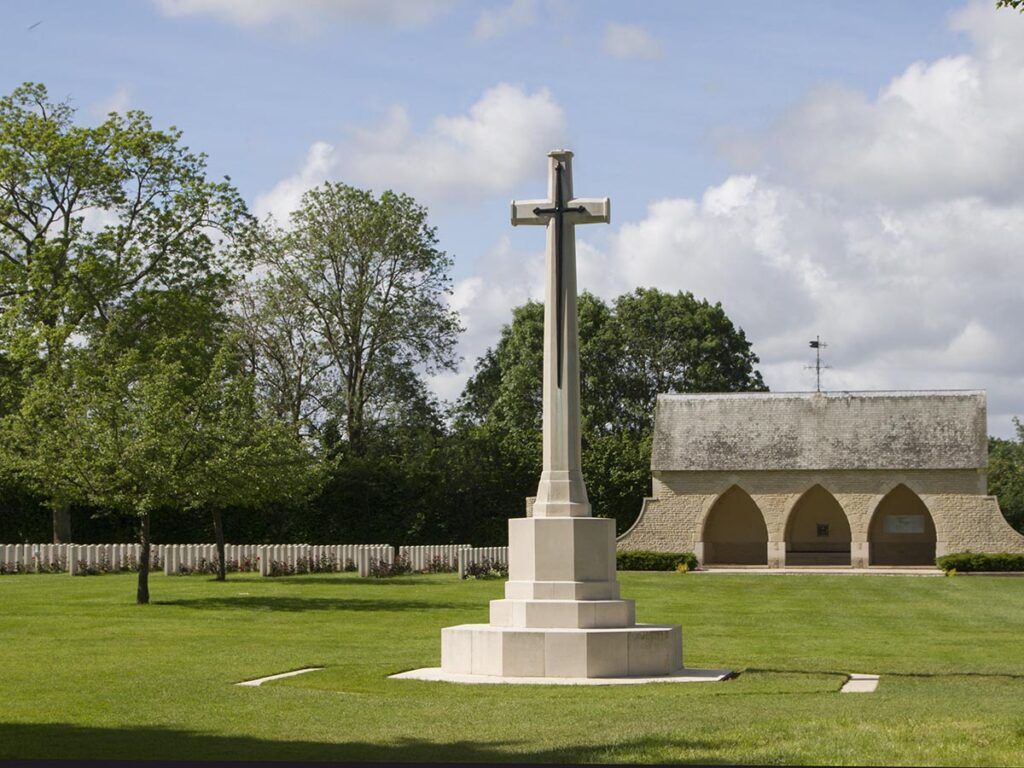
Hermanville-sur-Mer lies 13 kilometers north of Caen on the road to Lion-sur-Mer (D60). On the opposite side of the road to the church is the entrance to “Rue du Cimetière Anglais”. The Cemetery is around 300 meters along this road. There is plenty of parking just across from the entrance gate. Hermanville is located just behind Sword Beach where the British 3rd Division landed on D-Day. In the pavement outside the entrance to Hermanville War Cemetery is a large reproduction of the unit insignia of 3rd Division – an inverted red triangle inside a larger black triangle. It makes the entrance very easy to spot.
Originally known as Sword Beach Cemetery, many of those buried at Hermanville died on D-Day or during the first few days of the Normandy Campaign. However, there are also burials of naval personnel, Royal Marine Commandos and armored units involved in Operation Goodwood. The cemetery contains 1,003 burials, including 103 graves of the unknown.
There are three graves of French servicemen. Their headstones of white crosses are in stark contracts to the more familiar British and Commonwealth headstones. In addition, a number of the British graves belong to Jewish soldiers. These can sometime be seen with stones or rocks placed atop the headstone. This is a Jewish tradition which symbolizes the permanence of memory and legacy. Whilst flowers will eventually wither and die, the stones will remain.
Hottot-les-Bagues War Cemetery
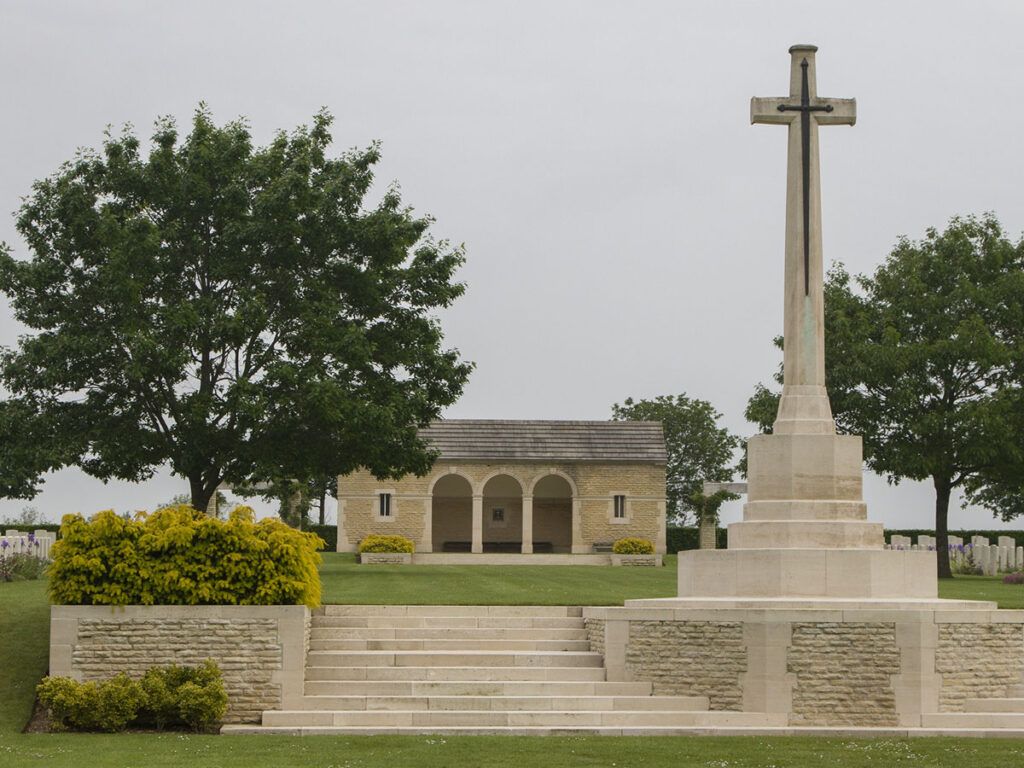
Hottot-les-Bagues War Cemetery is located along the D9 between Hottot-les-Bagues and Juvigny. There is a large paved lay-by offering decent car parking, but there are some steps to negotiate when accessing the Cemetery. The Cemetery is laid out on two levels with a set of steps or a steep grass bank linking them.
Most of the casualties buried in the Cemetery were killed in the latter half of June in the fighting around Tilly-sur-Suelles. Those buried here include Canadian officers attached to British units, Scots Guards, Duke of Wellington Regiment, Hampshire Regiment and the Parachute Regiment. Two Brigadiers are also interred here – one from the Seaforth Highlanders and the other from the New Zealand Infantry.
The cemetery contains 1,005 Commonwealth burials, 56 of them unidentified, and 132 German graves. There are 21 Special Memorials within the above, bearing the inscription “Buried near this spot”.
Jerusalem War Cemetery, Chouain
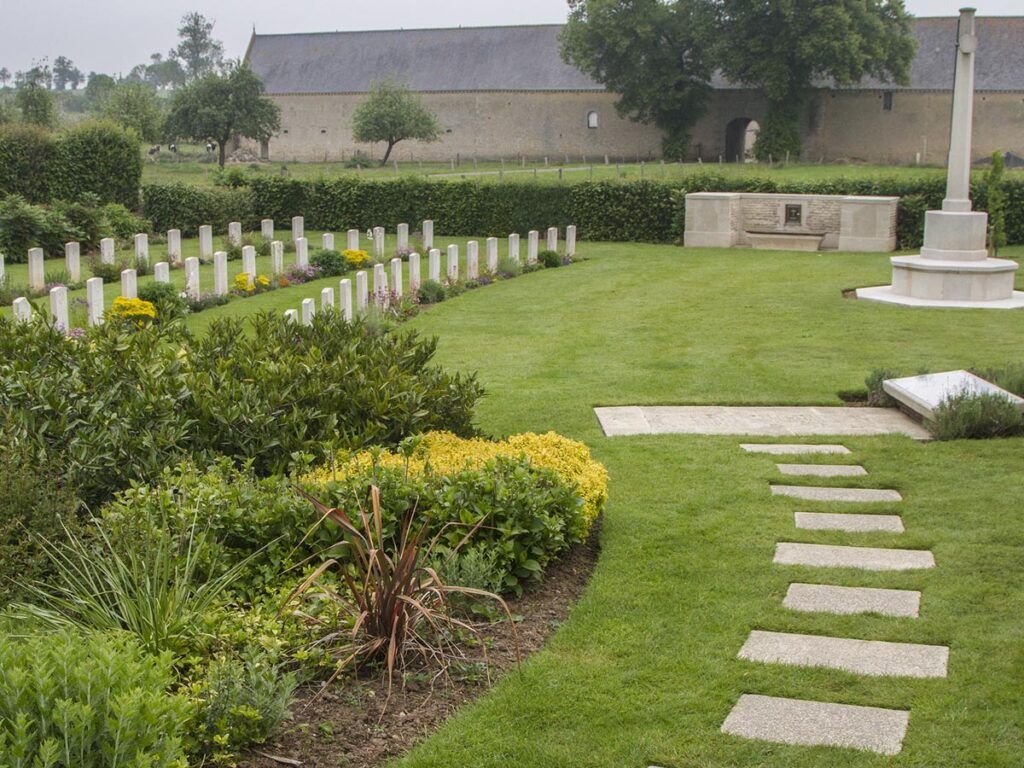
Located beside the D6 running south from Bayeux towards Tilly-sur-Suelles, the Jerusalem War Cemetery is just south of Chouain. The tiny cemetery has no parking but there are grass verges along the road. Be careful, as the road is lined on each side with a deep ditch. Other traffic also speeds along this road.
The area around the village of Chouain was the scene of bitter fighting when, shortly after the liberation of Bayeux, a German armoured column attempted to retake the town. Jerusalem was established in June 1944, and at the time nearby farm buildings were used by the RAMC as an advanced dressing station. As the fighting moved further south, the cemetery was no longer used.
The cemetery is one of the smallest Commonwealth war cemeteries, and is certainly the smallest in Normandy. There are just 47 graves including one which is unmarked, and another which belongs to a Czech soldier. Many of those buried here were killed in the fighting around Tilly-sur-Suelles and Lingevres. Two army chaplains are buried at Jerusalem, both killed in July 1944. It is also the final resting place of Private J. Banks of the 8th Bn Durham Light Infantry. When he was killed on 21st July 1944 he was still just 16 years old.
Ranville War Cemetery
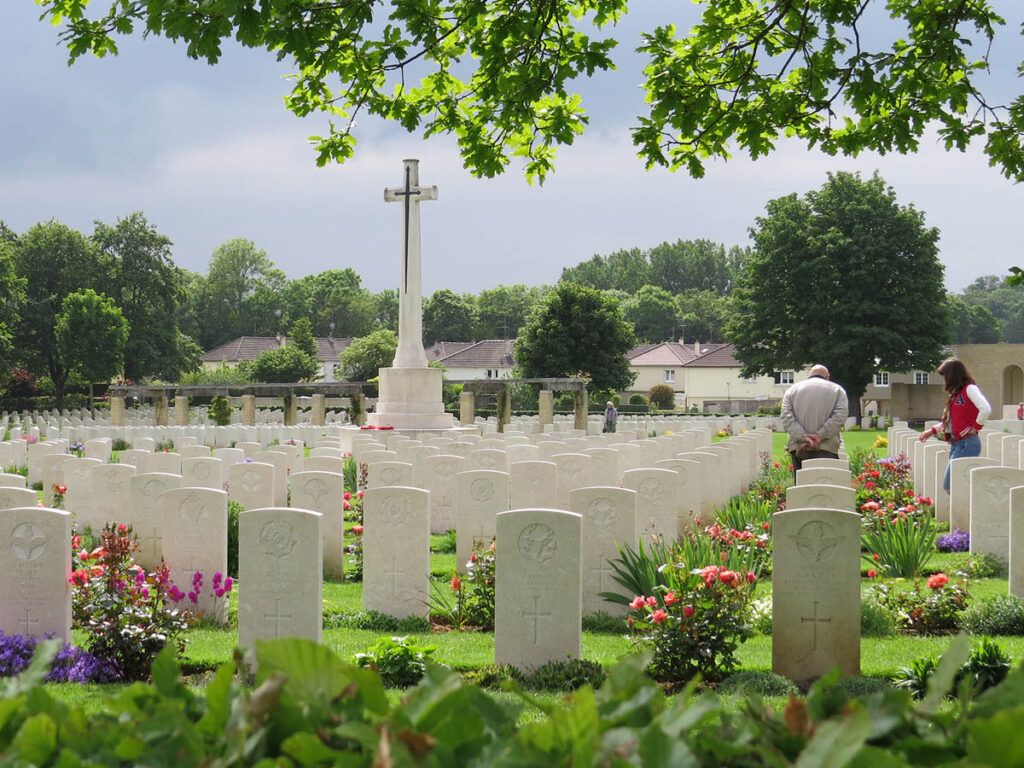
Ranville War Cemetery, located in the center of the first French village liberated during the D-Day landings, stands as a solemn memorial to those who fell in the early stages of the Battle of Normandy. Situated on “Rue Airbornes” next to the village church, this more open and less symmetrical Commonwealth cemetery contains 2,236 Commonwealth burials of the Second World War, including 90 unidentified soldiers, alongside 323 German graves and several other nationalities. The site holds particular significance as the final resting place of Lieutenant Den Brotheridge, believed to be the first Allied casualty on D-Day, who died from wounds sustained during the capture of Pegasus Bridge.
The cemetery honors many members of the British 6th Airborne Division, which played a crucial role in securing the area during the invasion’s earliest hours, including 76 members of the 1st Canadian Parachute Battalion who dropped alongside their British counterparts. Unlike other Commonwealth cemeteries in Normandy that feature more formal designs, Ranville presents a less regimented layout while maintaining the distinctive Hepworth design elements that characterize these memorial grounds. The adjoining churchyard contains an additional 47 Commonwealth burials, creating a peaceful sanctuary where both allies and enemies rest together, their sacrifice speaking to the tremendous human cost of liberation.
Ryes War Cemetery
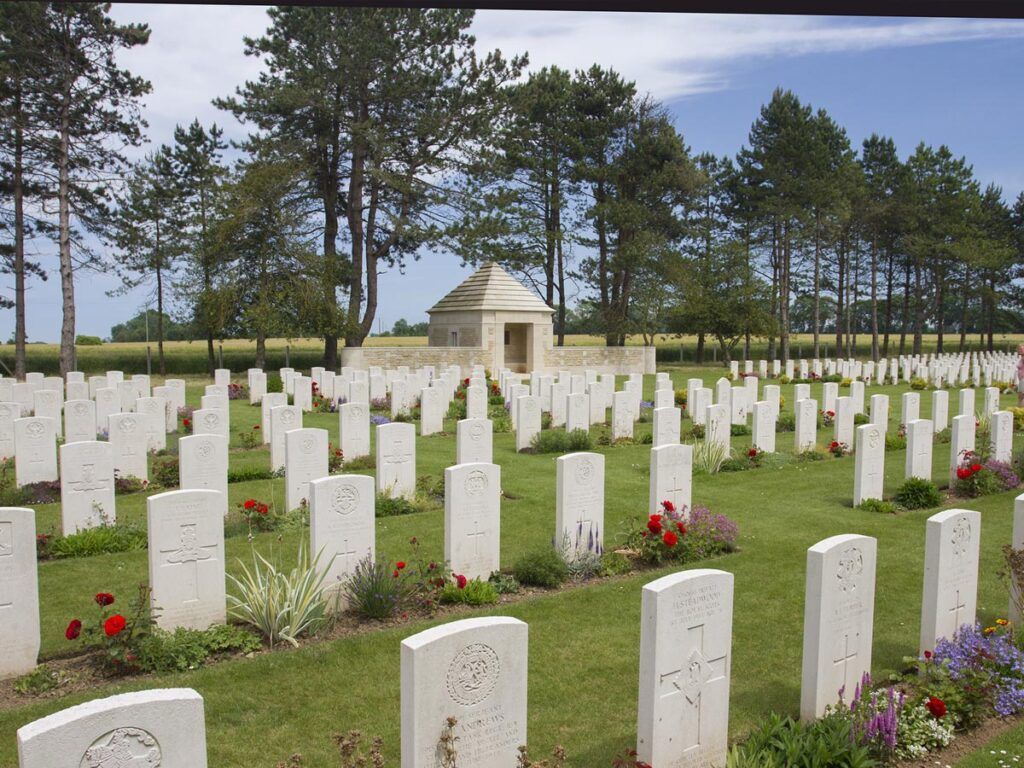
Ryes War Cemetery is located 8km east of Bayeux on the D87. It is actually slightly closer to the village of Bazenville than to Ryes. There is plenty of off-road parking but the road is narrow and turning round can be tight. The traffic along the road, whilst light, can move at some speed. In addition to the 652 Commonwealth graves, there are 335 German and one Polish burial. At certain times of the year the field opposite the cemetery bursts with a poignant red blaze of poppies.
The cemetery was started on 8th June 1944, following the 50th (Northumbrian) Division landing on nearby Gold Beach on 6th June. A chaplain is buried here, as are two brothers whose graves are side-by-side. A number of well decorated soldiers are buried here, including two Distinguished Conduct Medals, five Military Medals and a Distinguished Service Order.
St. Charles de Percy War Cemetery
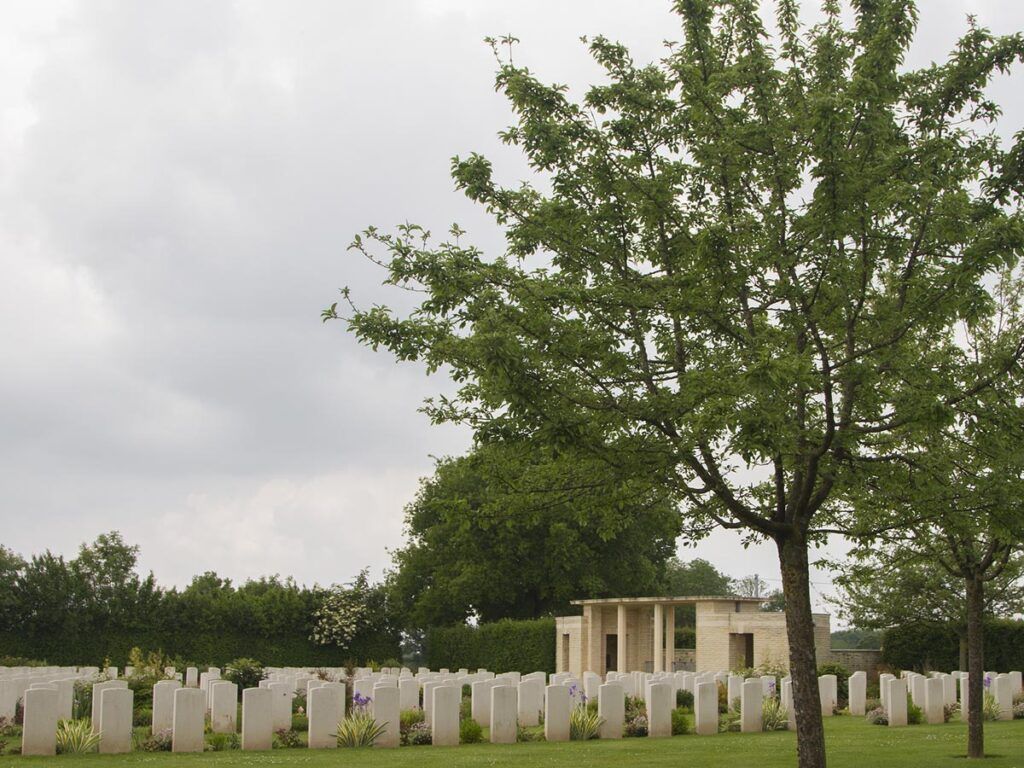
St. Charles-de-Percy can be a little tricky to find. From the little hamlet of La Ferroniere turn left onto the D56 and right again after a few hundred metres. The War Cemetery will then be found on the left hand side. There is designated off-road parking area.
The Cemetery is the southernmost of the Normandy cemeteries with the majority of the graves belonging to those who died in late July and early August 1944 in the push made from Caumont l’Evente towards Vire, to drive a wedge between the German 7th Army and Panzer Group West.
St. Charles-de-Percy War Cemetery contains 809 graves, including that of Sir Walter Balfour Barttelot, the Brigadier in command of 6th Guards Tank Brigade. He was killed in action on 16th August 1944 at Caumont.
St. Désir-de-Lisieux British War Cemetery
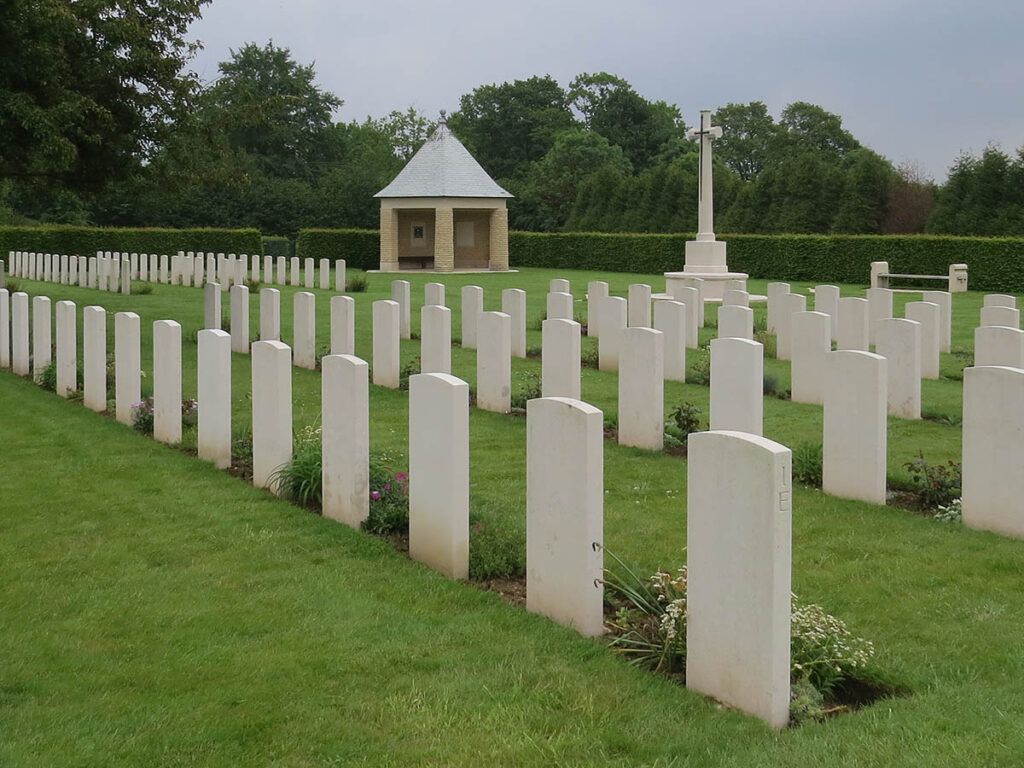
St. Désir lies 4km to the west of Lisieux. The Cemetery itself is about one kilometre west of the village and lies on a secondary road, the D159 in a pretty rural area. There are ditches on either side of the D159 outside the Cemetery which preclude parking, however, there is an area adjacent in which vehicles can park, although in wetter months this may be unsuitable for normal cars. St. Désir War Cemetery is unusual in that it is linked by pathway to a German cemetery. This is access via a road adjacent to the British cemetery and has much better parking available.
Between the British and German cemeteries is a meandering pathway which, half way between the two, has a small memorial and flagpoles with British, French, German and EU colours flying. The contrast is styles between the two cemeteries is quite striking.
The Cemetery is the most easterly of the the Normandy burial sites and, in the main, the soldiers interred here fell during the latter stages stages of the Normandy campaign as the Allies pursuide the German forces towards the Seine. There are 598 Commonwealth burials of which 78 graves were reinterred from Chartres (St Cheron) Communal Cemetery after the war, together with the four First World War burials. There are a large number of soldiers from the 51st (Highland) Division buried at St. Désir.
St. Manvieu War Cemetery
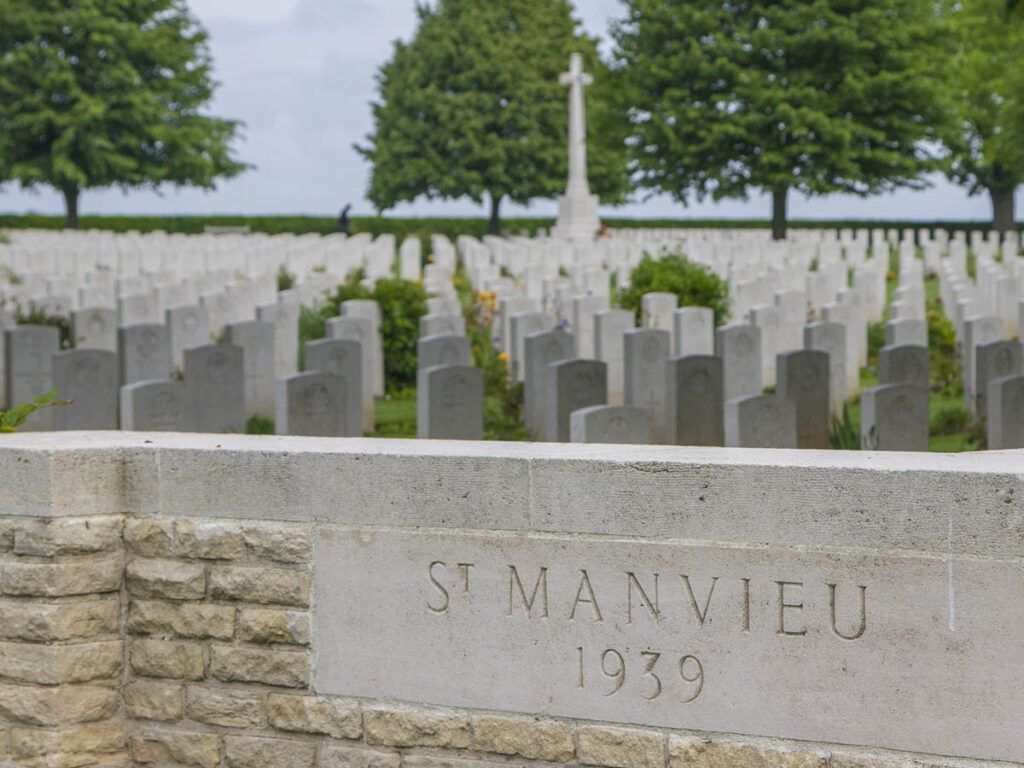
St. Manvieu War Cemetery is located on the D9 to the west of Caen. The entrance is reach via a short grass pathway on a slight upwards incline. There is a paved lay-by for parking but this can only accommodate a few cars at a time. The road is also quite busy with fast moving traffic. Many of those interred at St Manvieu fell during the battles for Tilly-sur-Suelles and Operations Epsom and Jupiter. The cemetery also containers graves of some of those killed in the battle for Hill 112.
The cemetery contains 1,627 Commonwealth burials, 49 of them unidentified, along with 555 German graves. A stretch of the D13 nearby – between Manvieu-Norrey and Fontenay-le-Pesnel – has a lovely strait, stretch of tree-lined road in the quintessentially French style.
Secqueville-en-Bessin War Cemetery
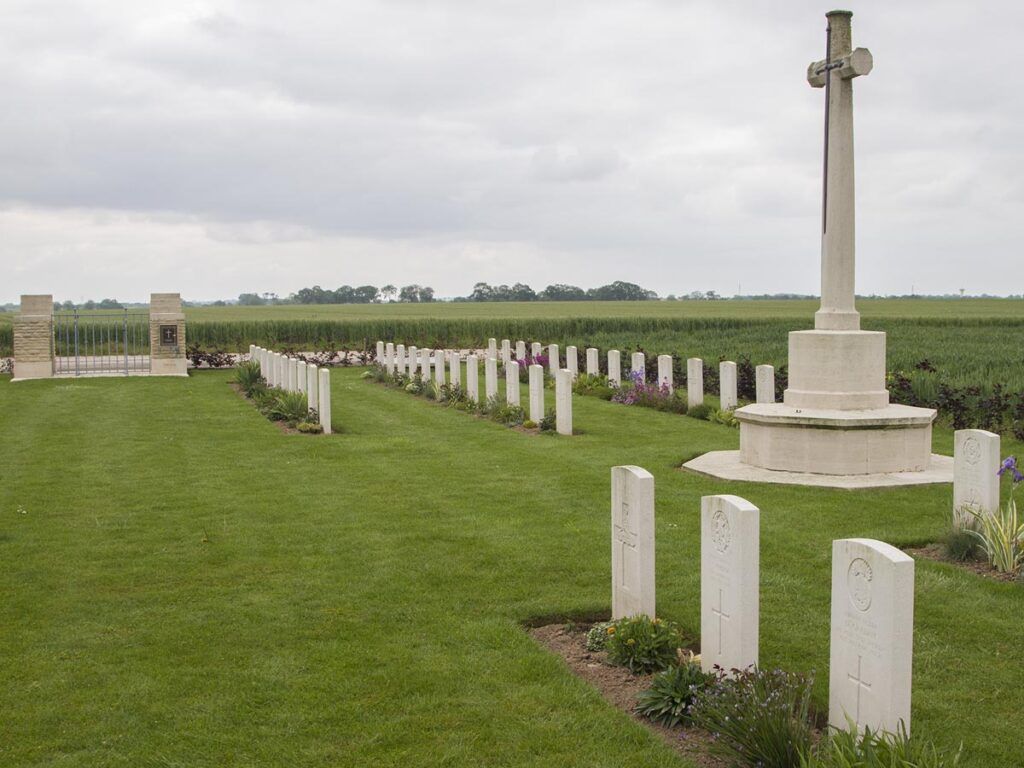
Secqueville-en-Bessin War Cemetery is located off the D83. It’s location can outsmart some sat-navs so we recommend going to the village of Secqueville and then following the normal Commonwealth War Graves Commission green signs. The cemetery is situated along a narrow track. Parking is limited and also tricky due to embedded obstructions in the ground and ditches. Turning a car can also be difficult due to the narrow width of the track.
The cemetery itself is slightly L-shaped and quite small with just 117 graves. The cemetery began near a field operating theatre and was originally somewhat larger. Canadian troops which were buried here were later reinterred at Reviers. The majority of the graves belong to members of the 15th (Scottish) and 43rd (Wessex) Divisions. In total there are 99 Commonwealth and 18 German burials.
Tilly-sur-Seulles War Cemetery
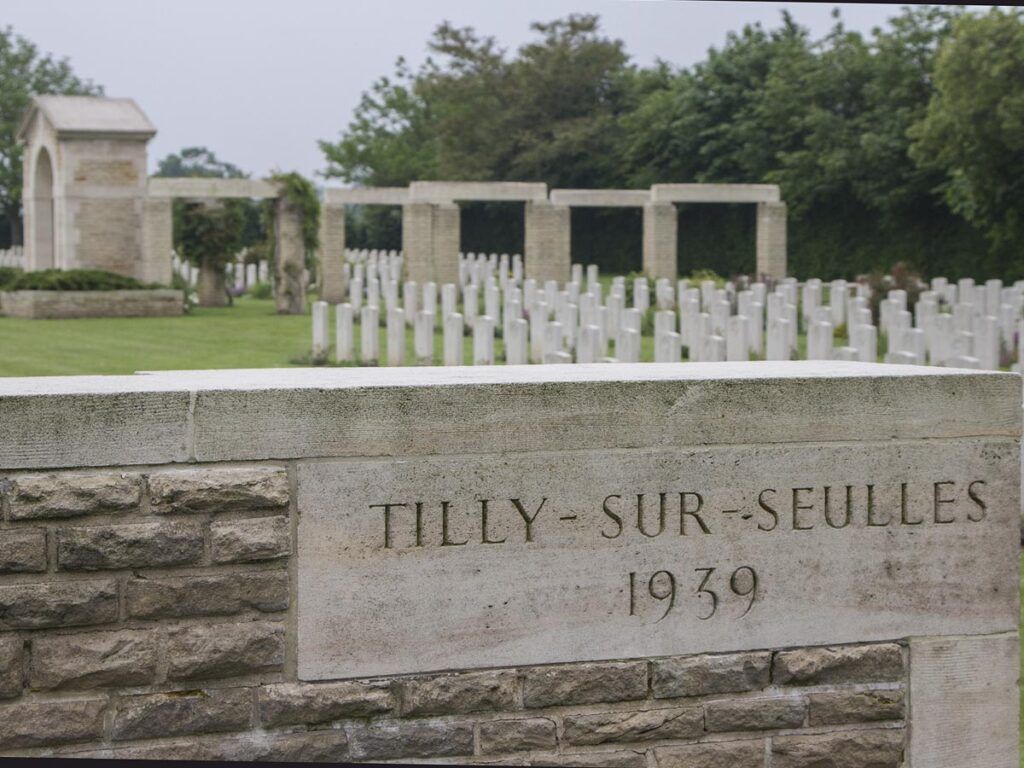
Tilly-sur-Seulles War Cemetery is about 12km south of Bayeux and sits roughly three quarters of the way from Jerusalem War Cemetery to Hottot-les-Bagues War Cemetery. Stay on the D6 until you enter Tilly-sur-Seulles, then turn right onto the D13 opposite the Marie. The Cemetery is about 1km on the left hand side of the road. There is a small lay-by on the other side of the road for parking.
Immediately following the landings there was heavy fighting in the vicinity of Tilly-sur-Seulles involving 7th Armoured, 49th and 50th Divisions during Operation Bluecoat. Tilly itself changed hands several times and was eventually captured on 18th June. Fighting continued nearby until mid July.
The first burial made at Tilly-sur-Seulles was on the 8th July. There are 45 unidentified graves amongst the 990 Commonwealth burials. There are also 232 German graves.
Tourgeville Military Cemetery
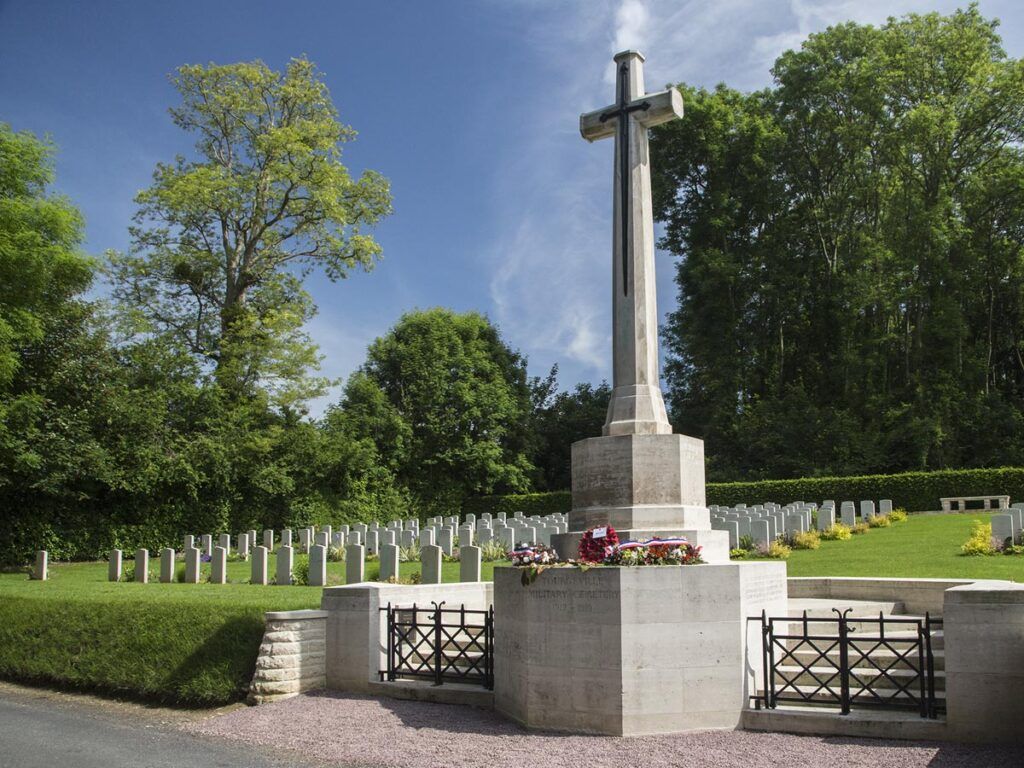
Not far from Deauville, the cemetery at Tourgéville Military Cemetery is actually a First World War cemetery. Nearby were the 14th Convalescent Depot, established in 1917, and the Trouville Hospital Area – eventually comprising the 72nd, 73rd and 74th General Hospitals and the 13th, 14th and 15th Convalescent Depots. Buried here are 196 British, 7 Canadian, 3 Australian, 1 New Zealand and 53 German soldiers, sailors, airmen, nurses and civilians of the First World War.
A short drive from the German battery at Mont-Canisy and down a narrow, winding lane the cemetery is small with just less than 292 identified casualties. It sits on a raised bank at the side of the road, and steps must be navigated to enter it and there is no wheelchair access to this cemetery. A small car park/turning area is located on the opposite side of the road. From the Second World War, there are the graves of 11 British, 2 Canadian and 33 Germans.
In 1993, the cemetery was used as a location in the moving climax to the BBC drama “A Foreign Field”, starring Alec Guinness, Lauren Bacall, Leo McKern, Geraldine Chaplin and Jeanne Moreau. The touching drama, written by Roy Clark (Open All Hours, Last of the Summer Wine) was originally released as part of the Screen One series, and for many years was only available on DVD through the BBC America website. Fortunately, it is now easy to purchase through Amazon. We highly recommend watching this 95-minute film.
Canadian Cemeteries
The success achieved by the Canadian forces on D-Day was remarkable. Around 14,000 Canadian soldiers stormed Juno Beach on 6th June, and by the end of the day they had progressed farther inland than any of the other Allied forces despite suffering 1,074 casualties, of which 359 were killed. They would be involved in a great deal more heavy fighting before the end of the Battle of Normandy.
Bény-sur-Mer Canadian War Cemetery
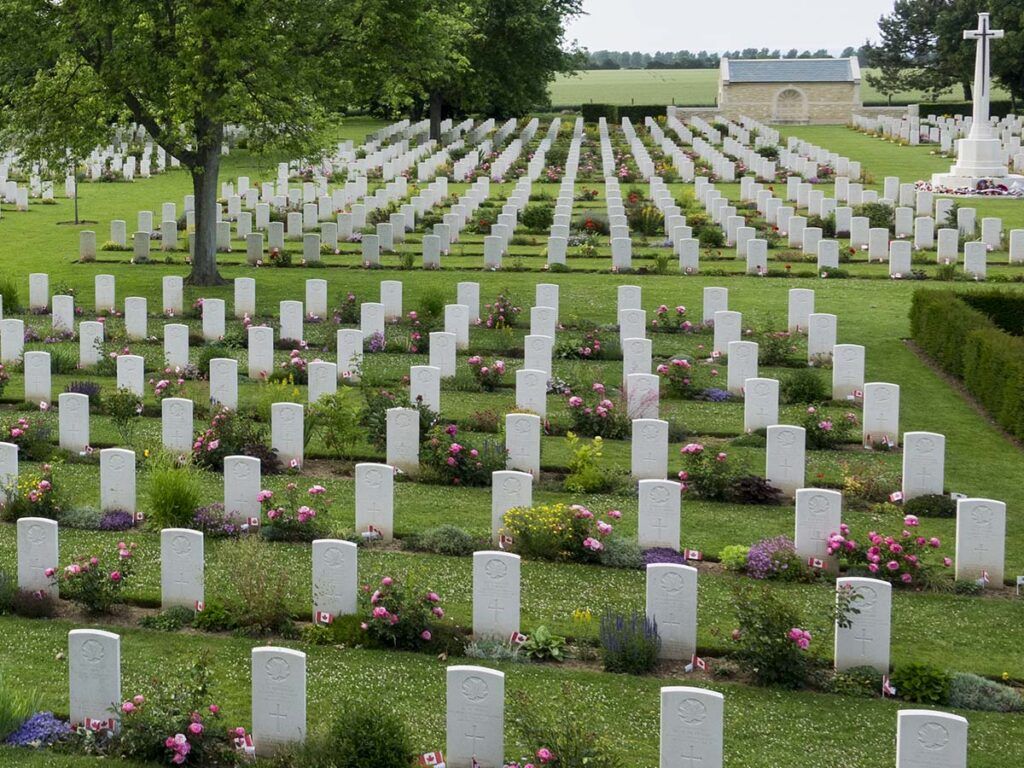
Located near to Reviers 18km east of Bayeux and 4km south of Courseulles-sur-Mer, is the Canadian cemetery at Bény-sur-Mer. There is ample parking adjacent to the Cemetery. The village of Bény-sur-Mer is some 2km southeast of the cemetery.
Bény-sur-Mer War Cemetery is the resting place for 2,048 fallen soldiers who were primarily killed during the early stages of the Battle of Normandy. The graves contain soldiers from the Canadian 3rd Division and 15 Airmen killed in the Battle of Normandy. The cemetery also includes four British graves and one French grave. The French grave belongs to a French resistance soldier named R. Guenard who fought and died alongside the Canadians and who had no known relatives. His marker is a grey cross and is inscribed “Mort pour la France- 19-7-1944”.
Because of confusion during the movement of remains from temporary cemeteries, the remains of one Canadian soldier were misplaced. His tombstone is set apart from the others and bears an inscription stating that it is known that his remains are in the Bény-sur-Mer. Bény-sur-Mer contains the remains of nine sets of brothers which is a record for a Second World War cemetery.
Bretteville-Sur-Laize Canadian War Cemetery
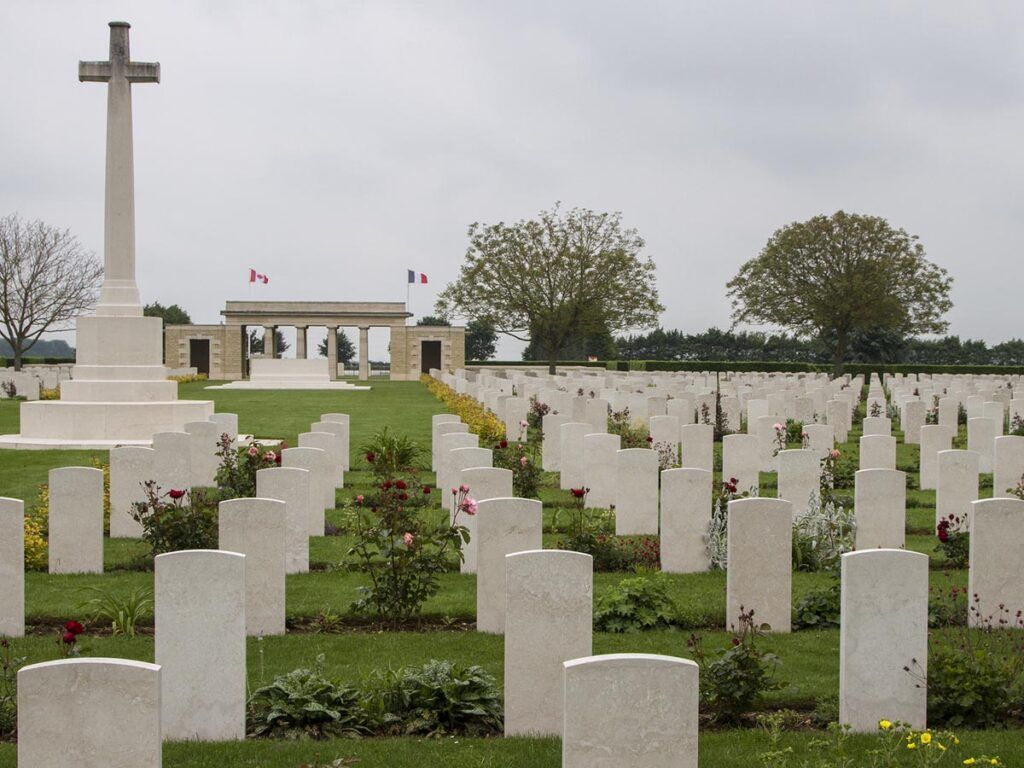
Bretteville-sur-Laize War Cemetery is situated on the main road between Falaise and Caen on the N158. It lies about 14km from Caen and just north of the village of Cintheaux. The village of Bretteville is 3km south west of the cemetery. The Cemetery is probably most easily seen from the air thanks to the enormous red maple leaf design built in to the surface of the car park area. Parking is ample although a short walk is required to get to the entrance of the Cemetery.
Bretteville-sur-Laize was created as a permanent resting place for Canadian soldiers who had been temporarily buried in smaller plots close to where they fell. There are 2,958 graves including 87 unidentified burials. Most of those resting at Bretteville died during the latter stages of the Battle of Normandy around Saint-André-sur-Orne in July 1944 and in the battle for the Falaise Pocket in August 1944. Almost every unit of the Canadian 2nd Corps is represented in the cemetery.
Outside the entrance to the Cemetery is a memorial in the shape of a maple leaf dedicated to Gérard Doré considered to be the youngest Canadian soldier to be killed during the Battle of Normandy. He volunteered for Royal Canadian Artillery at the age of 15, and was just four week shy of his 17th birthday when he was killed at the Battle of Ridge Canopies on 23rd July.
French Cemeteries
At the time of the Normandy Campaign the Free French forces number around 400,000 men. French Commandos landed at Sword Beach with the task of capturing the small port town of Ouistreham, suffering 21 men killed and 93 wounded. Armoured elements of the Free French Forces landed at Utah Beach on 1st August and later went on to liberate Paris. Some Free French parachutists also dropped into Normandy alongside the SAS.
Nécropole Nationale des Gateys
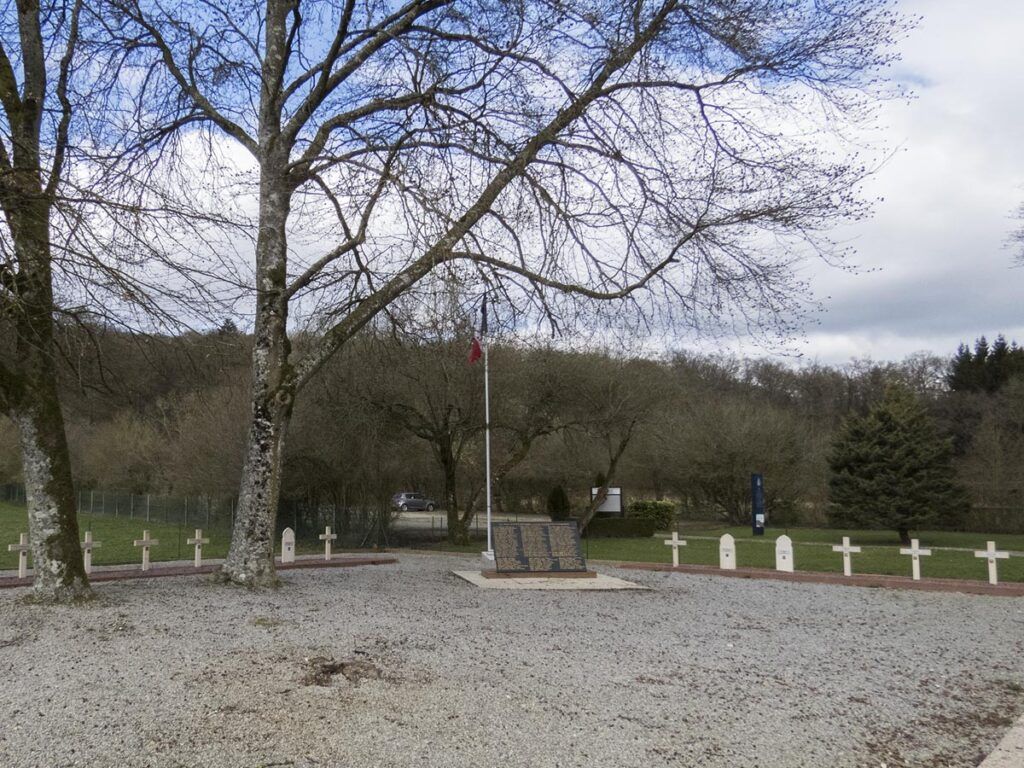
Located near the commune of Saint-Nicolas-des-Bois, the Nécropole nationale des Gateys lies on the D26 around 5km north of Alençon in the direction of Croix Médavy. It is poorly signposted and a bit tricky to find. There is ample car parking, but no other amenities.
The site was inaugurated in 1970, and contains the graves of 19 soldiers of the French 2nd Armoured Division who were killed in Battle of Alençon in August 1944. Their remains were moved from cemeteries in the surrounding communities. A black marble plaque is inscribed with the names of 69 soldiers from the 2nd DB (2nd French Armoured Division) who killed in the fighting for the liberation of the Orne department.
A few minutes’ drive from the cemetery you will find “Valois” – an M4A2 Sherman which serves as a memorial to those who fought and died with the 2nd DB. The tank served with the 12th RCA / 2DB, and was knocked out by German gunfire on 13th August 1944.
If you are in the region then it is worth making a stop at Les Gateys. However, unless you have a particular interest in the engagements of the French 2nd DB or the battles around Alençon, for most people there may not be enough here to warrant making a special journey.
German Cemeteries
Towards the end of the war, Germany had a near 100% conscription rate for men between the ages of 16 and 60. Even an exemption for sole surviving sons was revoked, and a special dietary battalion was created for men with severe stomach ailments. Many old men and young boys were sent to the western front to await the Allied invasion. The total number of German casualties on D-Day is not known, but it is estimated that between 4,000 and 9,000 were killed.
Champigny-Saint-André German War Cemetery
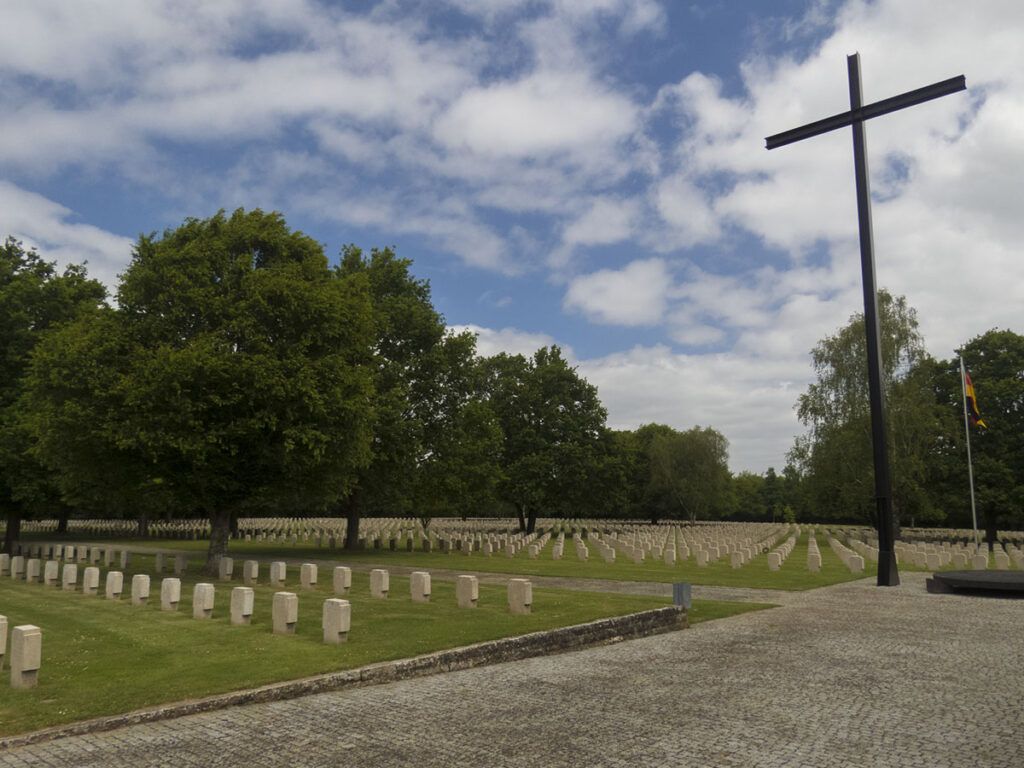
Situated between Saint-André-de-l’Eure and Champigny-la-Futelaye, Champigny-Saint-André is the easternmost German war cemetery in Normandy, lying closer to Paris than Caen. Originally established during the August 1944 fighting as Allied forces advanced toward the Seine, it was initially administered by the American Graves Registration Service before being expanded to include reburials from various locations including the Ivry civilian cemetery in Paris. The cemetery as it exists today was officially inaugurated on September 12, 1964, and contains over 19,830 German war dead, including a mass grave of 816 soldiers. Notable burials include General Friedrich Dollman, Otto von Stülpnagel (German military commander in France), and fighter ace Josef “Sepp” Wurmheller.
Visitors enter via a tree-lined drive leading to ample parking and a small visitor center featuring a site plan and information materials. The grounds include travertine limestone pillars inscribed with the names of cities from which burials originated, and are dominated by a 16-meter steel cross. The cemetery’s striking chapel features white stone walls adorned with relief sculptures and colorful glass panels that illuminate the interior when sunlight streams through. Throughout the cemetery, limestone markers bear names on both sides, each showing the ranks and dates of the adjacent fallen. While lacking colorful flower beds typical of Allied cemeteries, the grounds feature mature trees and many graves are adorned with traditional dried flower wreaths, creating a solemn, contemplative atmosphere.
La Cambe German War Cemetery
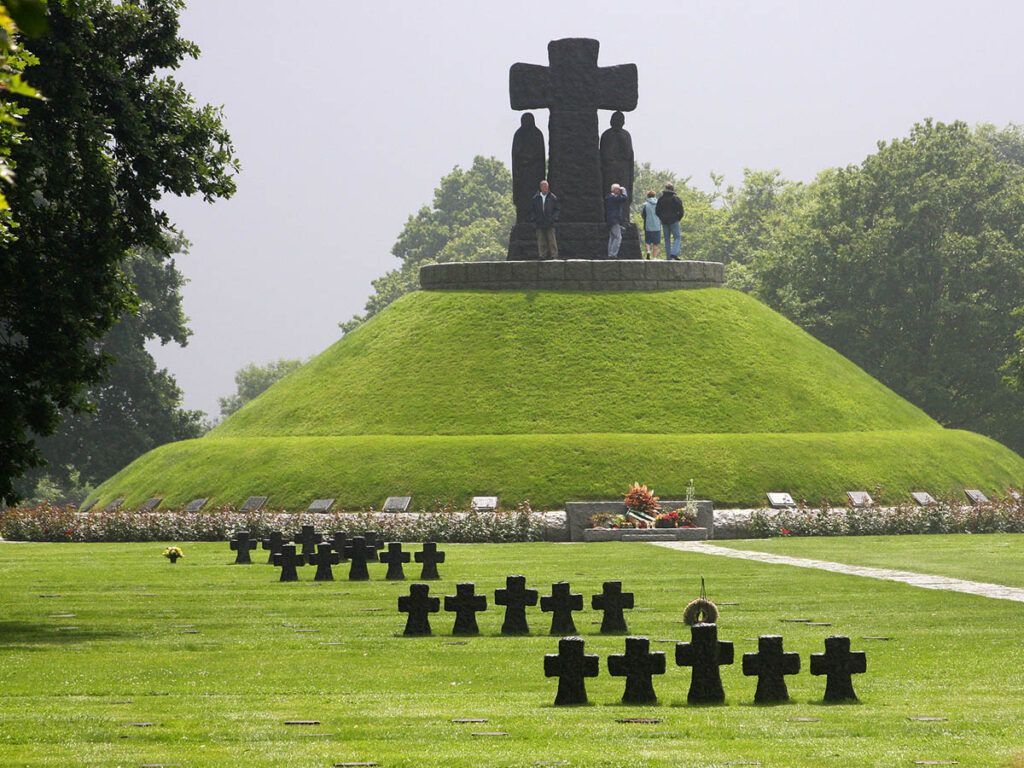
Easily accessible from the main N13 highway with ample parking, La Cambe German War Cemetery is a solemn memorial containing 21,222 German burials, including 207 unknown soldiers. Originally established by the U.S. Army Graves Registration Service as a cemetery for both American and German casualties, it became exclusively German after American remains were transferred to Colleville-sur-Mer or repatriated. Unlike Allied cemeteries, La Cambe features distinctive grey schist crosses that don’t mark individual graves, with burial locations instead indicated by ground-level plaques. Most of those interred here fell between June 6 and August 20, 1944, with ages ranging from 16 to 72. Notable burials include tank commander Michael Wittmann and SS-Sturmbannführer Adolf Diekmann, who was involved in the Oradour-sur-Glane massacre.
A visitor center established in the mid-1990s provides information about Operation Overlord casualties and houses a database for locating specific graves, along with an exhibition about the German War Graves Commission. Adjacent to the cemetery is a peace garden featuring 1,200 maple trees, creating a contemplative atmosphere. Unlike American and Commonwealth war graves organizations, the German Commission operates entirely on voluntary contributions. During summer months, international students often volunteer to tend the graves as part of educational programs that include visits to various war cemeteries and participation in memorial ceremonies with veterans and local officials. The cemetery is open daily from 8:00 to 19:00, with the visitor center operating during the same hours except for a midday closure.
Marigny German War Cemetery
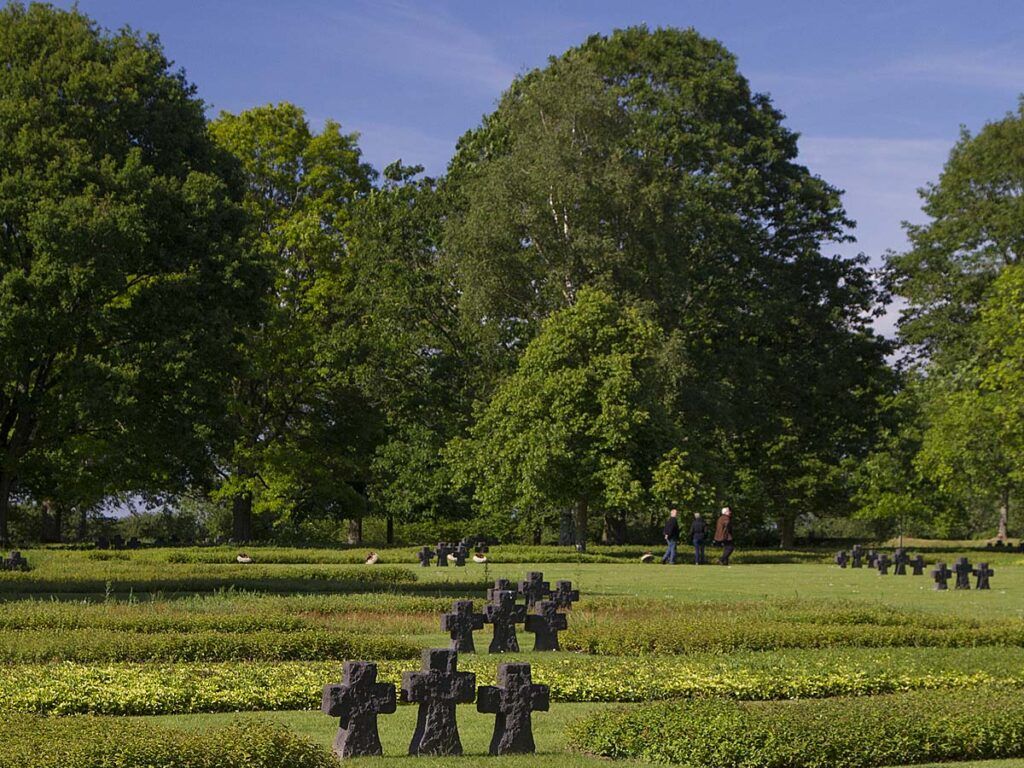
The German cemetery at Marigny is located on the D341 on the outskirts of the town of La Chapelle-en-Juger which is just west of Saint-Lô. There is a decent amount of parking and there is a small visitor center with very clean toilettes. Entrance to the Cemetery is through a church-like building constructed from local schist. Just past the ornate metal entrance gate is an alcove with a religious mosaic.
Marigny has a very different feel to the other cemeteries in Normandy and has a far more somber atmosphere. An abundance of mature trees and the simple yellow flowers of St John’s Wort which separate the rows of graves mean there is little colour. The graves are also marked by flat ceramic plates rather than headstones, so the groups of three ornamental crosses are really the most dominating characteristic when looking across the cemetery.
The Cemetery was opened by the Americans who wished to give their casulaties from Operation Cobra a decent burial. The American dead were later reinterred at the Saint-James and Colleville-sur-Mer cemeteries, and the cemetery was later given to the German government. As with the French and Allied Forces, many Germans had been hastily buried in field graves and small cemeteries dispersed across the Cotentin Peninsula. The remains of the German soldiers who died during the Battle of Normandy were exhumed and grouped in Marigny between 1959 and 1961. The youngest soldier buried at Marigny was not even 15 years old.
General Erich Marcks is among the soldiers buried at Marigny. Mortally wounded during the aerial bombardment of Saint-Lô, Marcks celebrated his 53rd birthday on 6th June. General Marcks was convinced the Allies would land at Normandy, contrary to the opinion of many in the Wehrmacht.
Mont-de-Huisnes German War Cemetery
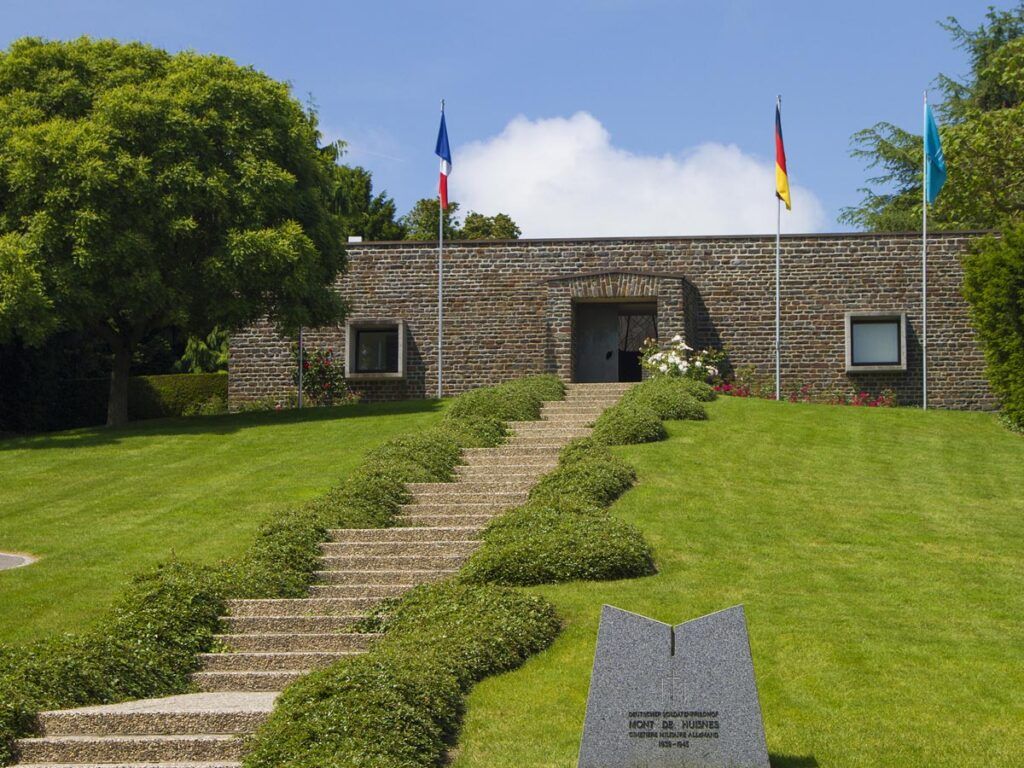
Mont-de-Huisnes is the most westerly of the Normandy cemeteries, situated not far from the historic abbey of Mont St Michel close to the border with Brittany. One kilometre north of the village of Huisnes-sur-Mer, the cemetery sits atop a 30m hill. There is ample good parking outside which benefits in the summer from the shade of mature trees. Entrance to the cemetery is via a set of easily negotiated steps, however, there is also a ramp for wheelchair access.
Upon entering the reception building visitors are presented with a beautiful, ornate floor-to-ceiling patterned window. Past this are some more shallow steps which need to be navigated to gain access to the cemetery proper – which is completely different to any other Normandy war grave site. The cemetery comprises a two-storey circular construction with 34 crypt chambers on each level. Each of these chambers holds 180 German war dead. The building surrounds a 47m diameter lawn which has a large cross in its center, and on the far side are steps to a viewing area which looks out across to the famous shape of Mont St Michel.
Inaugurated on 14th September 1963, the cemetery contains the remains of some 12,000 fallen soldiers. Some bodies were reinterred here from burial sites in the Channel Islands and from various other regions of France, including Sarthe, Morbihan and Ille-et-Vilaine. Upon many of the graves within the crypt rooms tributes of dried flowers have been left. This seems to be more common at German cemeteries than the placing of fresh flowers.
Mont-de-Huisnes really is an incredibly moving place to visit and the arrangement of the bodies gathered together in crypt rooms especially highlights the enormous human cost of battle. We strongly recommend making the journey from the landing beach area of Normandy.
Orglandes German War Cemetery
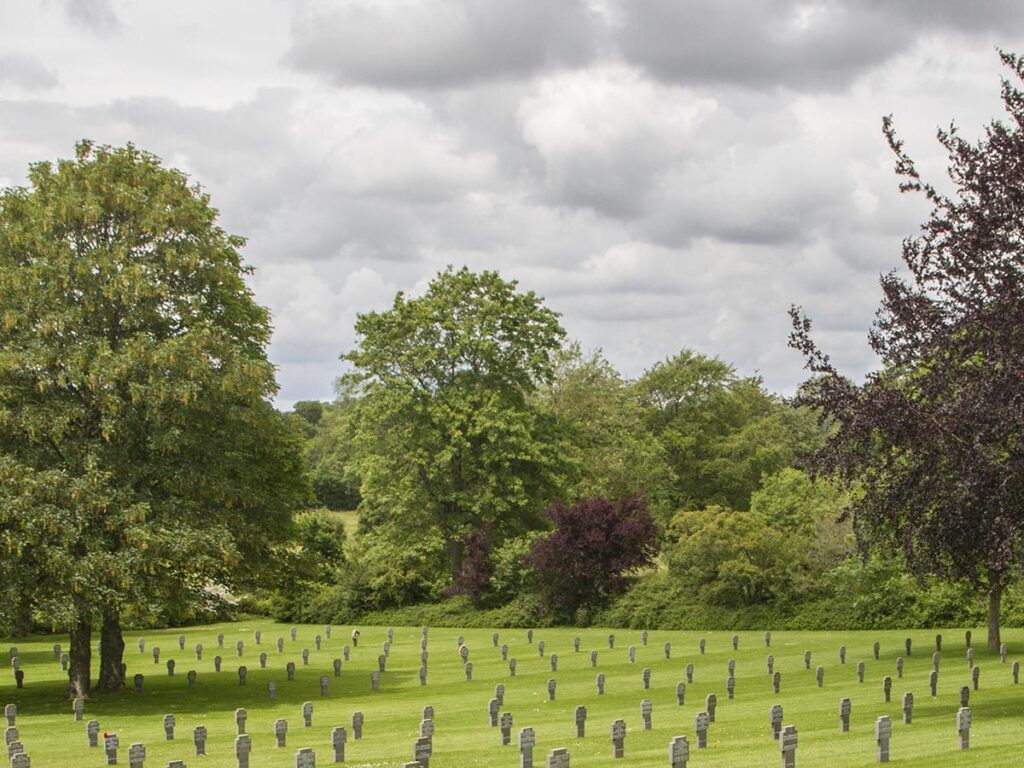
The German cemetery at Orglandes is located around 7km west of Ste Mere Eglise on the D24 south of Valognes. There is dedicated off road parking for a number of vehicles, but the ground is cobbled so walking may be awkward for some. The entrance is marked by an attractive, church-like building with a bell-tower. There is no dedicated visitor center, however, once inside the cemetery a left turn and a short walk will take you to some toilettes if required.
The Cemetery was initially the resting place for both American and German soldiers. After the war 7,358 German and several thousand American war dead were buried at Orglandes. The American dead were reinterred at the Colleville-sur-Mer cemetery, and between 1958 and 1961 Orglandes was redeveloped by the Volksbund. Over time, other German war dead were moved here from smaller sites and there are now 10,152 graves at the site, arranged in 28 rows, each marked with a stone cross.
St-Désir-de-Liseux German War Cemetery
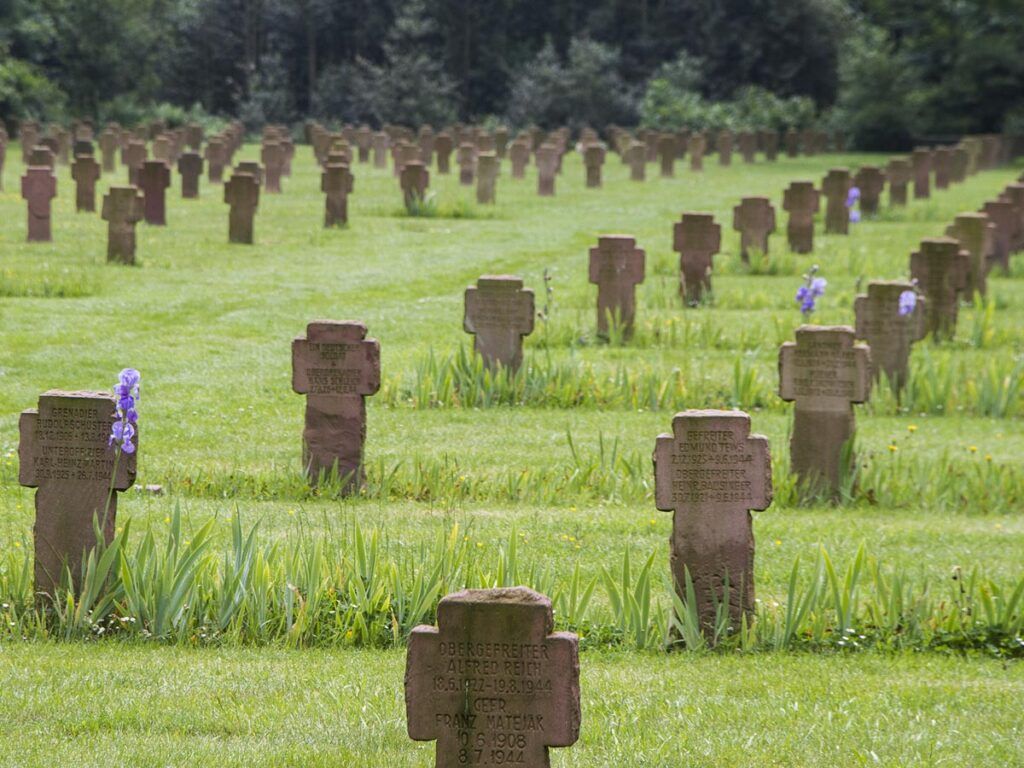
St-Désir lies 4km to the west of Lisieux. The German Cemetery is about one kilometre west of the village and lies just off the D159 – located adjacent to the British Cemetery of the same name. There is a small tree-shaded area for parking immediately outside the cemetery entrance. These two cemeteries are the most easterly of the Normandy burial sites.
Between the German and British cemeteries is a meandering pathway which has a small memorial and flagpoles in the center, with British, French, German and EU colours flying. The contrast is styles between the two cemeteries is quite striking.
This is the smallest German cemetery in the Normandy region. Beneath the red sandstone crosses are the graves of 3,735 fallen German soldiers, many from the 15th Army, 7th Army and 5th Panzer Army. The majority of soldiers here were killed in the last days of the Battle of Normandy, during the German retreat towards the Seine in August 1944, and were buried by the British Graves Service. St-Désir is known for being the resting place for many of the newly discovered remains from the Normandy campaign.
The remains of German fighter ace Egon Mayer lay at St-Désir. Meyer was responsible for 102 kills during 353 missions over the western front, including 26 four-engined bombers, 51 Spitfires and 12 P47 Thundebolts. It was a P47 piloted by Lt. Walter Gresham of 358th Fighter Squadron which finally ended his reign of terror in March 1944 near Mont Médy.
Polish Cemetaries
Poland was the only country to fight in the European theatre from the first to the last day of the Second World War. In the Normandy Campaign, General Maczek’s 1st Polish Armoured Division, under command of the Canadian Army, first seeing action during Operation Totalize between 8th and 13th August. They also helped seal the gap in the Falaise Pocket cutting off the German escape route. Later they helped to liberate Holland and Belgium.
Urville-Langannerie Polish War Cemetery
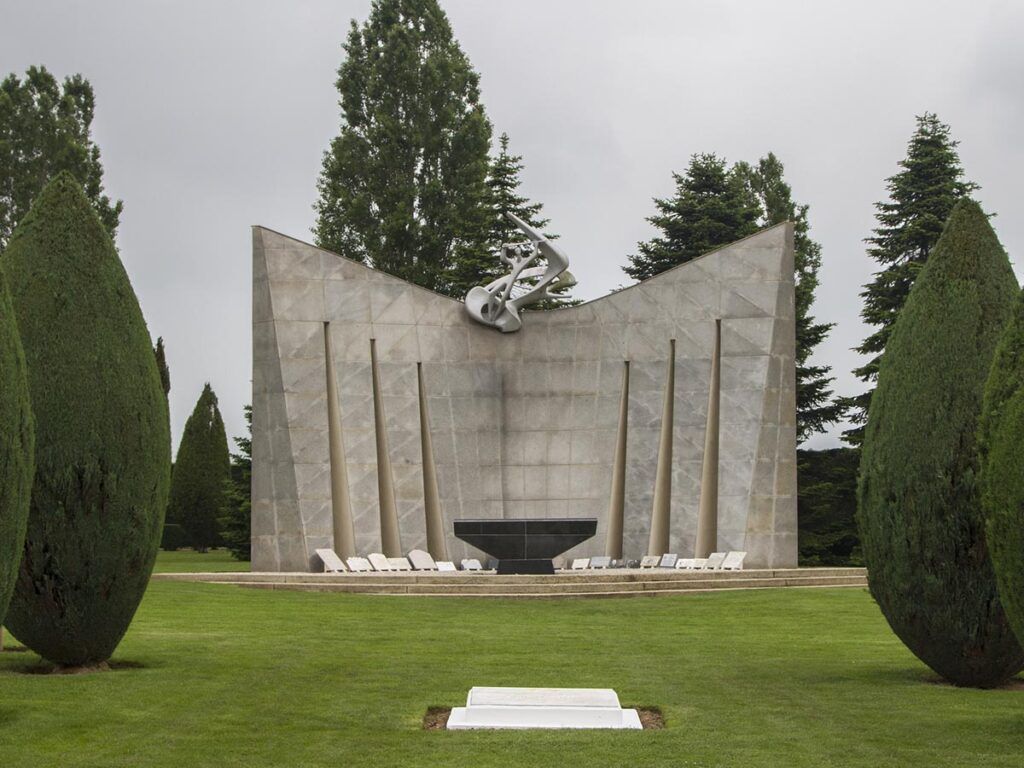
The only Polish war cemetery in Normandy, Urville-Langannerie is located just off the N158 near the small town of Grainville-Langannerie about half-way from Caen to Falaise. There is off-road parking available for cars and coaches just outside. It should also be noted that the gate to enter the Cemetery is very stiff as it rubs on the stone paving.
There are 696 graves at the cemetery, with most of the fallen having died during the capture of Caen and battle to close the Falaise gap. 615 of those interred here belonged to the 1st Armoured Division under Gen. Stanislaw Maczka. The remaining graves belong mainly to Free Polish forces who fell in other parts of France and were reinterred here.
The cemetery is dominated by a large V-shaped monument at the far end, upon which sits a large aluminium sculpture representing the Polish eagle. Upon many of the graves small tokens are left, including a considerable number of rosary beads. The Cemetery is maintained by the French Anciens Combattant veterans association.
When visiting Urville-Langannerie, it is worthwhile to remember that the Canadian Cemetery at Bretteville-sur-Laize is just 5km to the north along the N158.

